Why now is the best time to go penguin-spotting in Patagonia (and other great times to visit)
Dec 13, 2021 • 8 min read
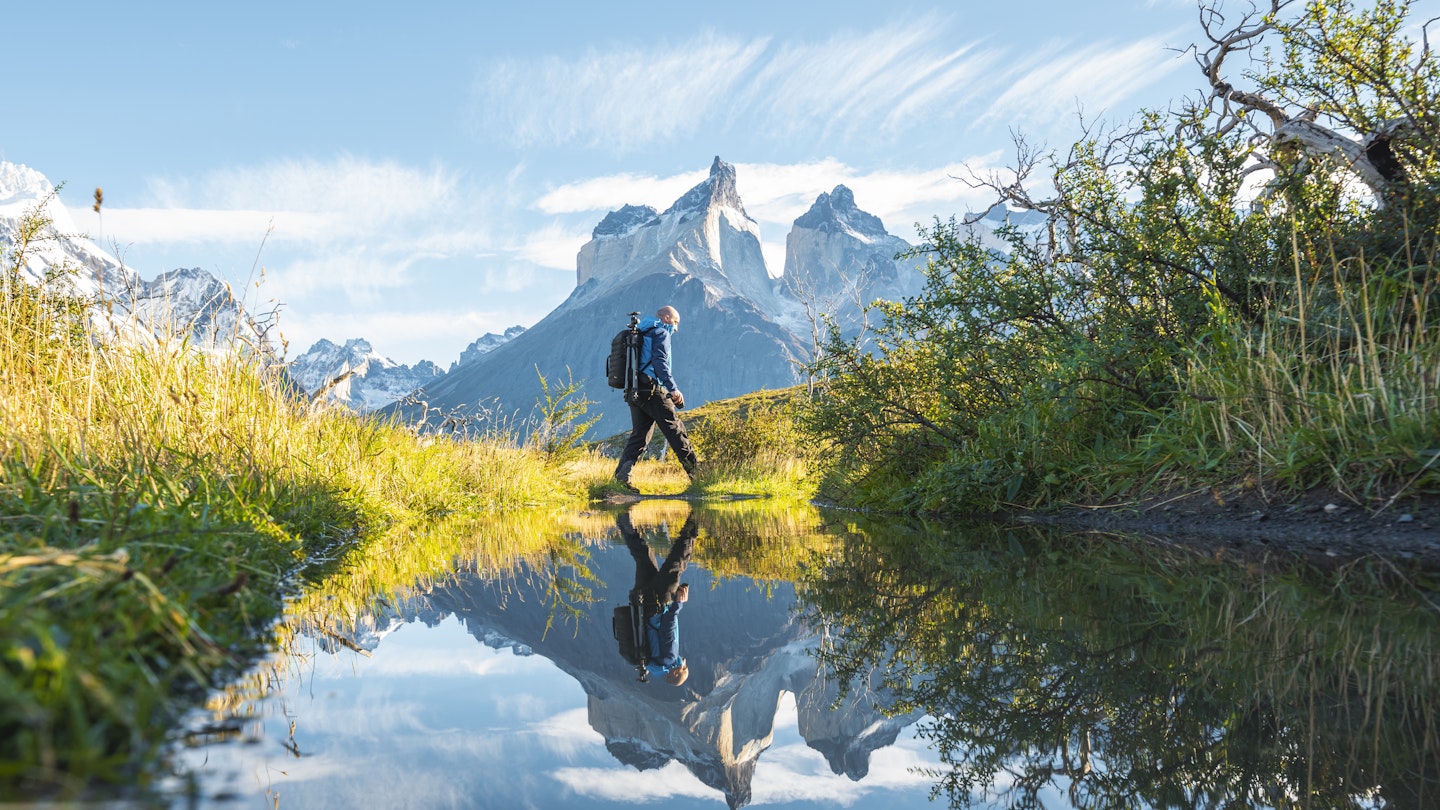
Smaller visitor numbers and cooler nights make March the best time to visit Torres del Paine National Park in Patagonia © Marco Bottigelli / Getty Images
Patagonia – a vast slice of southern Chile and Argentina – evokes images of endless pampas, mountain ranges and glacial rivers, of wide open spaces enticing exploration. A vast playground for fresh air fiends, it’s a terrific destination for numerous outdoor activities besides world-class trekking and horseback riding: white-water rafting, ice climbing, kayaking in meltwater lakes beside bobbing, house-sized chunks of ice, and wildlife-spotting.
There are gentler ways to get to know Patagonia’s natural attractions, too: You can get up close and personal with vast glaciers by taking boat cruises and visit penguin colonies by boat or with your own set of wheels. The best time to visit Patagonia largely depends on what you want to do. Some outdoor activities are weather-dependent and confined to the November to March season (late spring to early fall in the southern hemisphere). Winter (June to August) is quietest, yet it’s also the best time to hit the slopes in the nearby Tierra del Fuego .
Whenever you visit, be sure to pack a windbreaker and multiple layers, since Patagonian weather is known for its capriciousness and you may experience four seasons in one day even at the height of southern summer.


High Season – December to February – is the best time for hiking, whitewater rafting and penguin-spotting
The weather is at its best during Patagonia’s summer. You may enjoy warm, long days (punctuated by gusts of fierce Patagonian winds) as you hit the hiking trails or Chile’s whitewater rapids. Penguins return to their nesting sites for the summer. Accommodation prices shoot up by up to 50%, so you’ll need to make your travel arrangements months in advance, particularly if you have your heart set on trekking in Torres del Paine National Park or for the peak months of January and February that coincide with local holidays.
Shoulder Season – March to mid-April & November – is the best time for photographers and crowd-free hiking
Early fall (March to mid-April) is a gorgeous time to be outdoors as the deciduous trees turn red-gold and the winds are not as strong as in spring. If you don’t mind the cooler temperatures, it’s a good time to go hiking without the crowds and take advantage of lower accommodation prices. Bear in mind that in late spring (November), some trails may still be closed by snow.
Low Season – May to October – is the best time for winter sports
With the southern mountain ranges carpeted in snow, this is the ideal time to head for Tierra del Fuego’s southernmost city, Ushuaia , to hit the slopes at the world’s southernmost ski resort. Alternatively, you can go skiing in Esquel or even Punta Arenas .
Most attractions, accommodations and restaurants will shut in Chilean and Argentinian Patagonia at this time of year. Travel is logistically tricky, but experienced, self-sufficient, all-season trekkers can still go snow-shoeing in the national parks and trace guanacos (wild cousin of the llama), puma and huemul (endangered deer) by the animal tracks in the snow.

Peak summer season. It coincides with school and university summer vacation in both Chile and Argentina. Long, warm days and optimal hiking conditions mean that you need to book accommodation several months ahead, particularly in Patagonian hotspots with limited accommodations like Torres del Paine, El Chaltén , El Calafate ). It’s a superb time for white-water rafting in Futaleufú, for checking out sheep-shearing festivals in Villa Tehuelches and experiencing the biggest rodeo in northern Patagonia at Puerto Ibáñez.
Key Events: Festival de Artesanía y Turismo, Puerto Natales; Fiesta Nacional de la Esquilla, Villa Tehuelches, Río Mayo; Jineteadas, Puerto Ibáñez), Aniversario de Chile Chico, Chile Chico
This is the height of southern summer, so accommodation prices remain high. However, it’s the best month for festivals and outdoor sports events like Tierra del Fuego’s biggest barbecue, Cochrane’s culture fest or the Terra Australis mountain bike race. There are also bouldering competitions in El Chaltén, the world’s southernmost marathon and white-water rafting, kayak and cataraft events in Futaleufú.
Key Events: Asado de Porvenir; Terra Australis, Punta Arenas; Feria de Cochrane; Festival de Boulder, El Chaltén; Futaleufú XL; Maraton Fin del Mundo, Ushuaia; Expo Patagonia, Coyhaique
The icy lakes in the national parks reflect the red-gold foliage of the forests, making March the perfect time of year for photographers to get the best nature shots. Smaller visitor numbers and cooler nights mean it’s easier to book accommodation in Torres del Paine National Park and elsewhere. This month is also Ideal for visiting Patagonia’s biggest outdoor attractions.
Key Events: Fiesta Nacional del Trekking, El Chaltén;de Fiesta de Pesca del Salmón, Gobernator Gregore; Encuentro Costumbrista y Tradiciones, Villa La Tapera; Festival Jineteadas, Coraje y Amistad, Cochrane; El Día del Ternero, La Junta
There’s still plenty of daylight in April, so falling temperatures and low visitor numbers mean increased animal sightings in the national parks. Prices and local visitor numbers briefly shoot up for Easter. Fly fishers in northern Patagonia have the rivers largely to themselves as they make the season’s biggest catches before the waters freeze over.
Key Events: Semana Santa; FECIPA (Festival de Cine Patagonia Aysén), Coyhaique; Fiesta Costumbrista Curanto y Kuchen, Puyuhuapi; Fiesta Costumbrista del Salmón, Puerto Chacabuco; Encuentro Provincial de Ceramista, Villa Rada Tilly
Winter is on its way, so expect cold, wet weather and the first snowfalls. Towns with ski resorts like Ushuaia and Esquel begin buzzing with activity in anticipation of winter season. There are still daily bus services to Torres del Paine National Park (with the mountains particularly lovely with a dusting of snow) and the Perito Moreno glacier is crowd-free (though with less iceberg calving due to cold weather).
Key Events: Semana Aniversario, Puerto Natales; Semana Aniversario, Caleta Tortel

Temperatures drop, snowfall continues and towns in Patagonia celebrate the longest night of the year with music events and fireworks. In Ushuaia, there are Nordic ski processions as well. Much of Patagonia is quiet, but ski resorts come to life as skiers and snowboarders head for the slopes in Ushuaia, Esquel, Punta Arenas and Río Turbio.
Key Events: Fiesta de la Noche Más Larga, Ushuaia & Punta Arenas; Semana de la Fauna Marina, Puerto Madryn
One of the best months for skiing, July has reliable snowfall. If whizzing down glaciers and mountain slopes is not your thing, you can take part in Ushuaia’s Nordic ski and biathlon events. Or else escape the cold by checking folkloric music performances in Punta Arenas, or partake in high tea in Trelew’s celebration of its Welsh roots.
Key Events: Festival de Esquí de Fondo & Biathlon, Ushuaia; Festival Folklórico, Punta Arenas; Fiesta de la Nieve, Puerto Williams; Fiesta del Hielo, El Calafate; Fiesta Galesa de Desembarco, Trelew
Temperatures remain firmly low. Luckily, so do Patagonia’s winds, making skiing a pleasure. Take part in Ushuaia’s annual ‘white walk’ (Nordic ski races), join Esquel’s torchlit ski procession, else go husky sledding in Ushuaia’s Valle de Lobos . Whale-watching season also kicks off in Argentina at Península Valdés.
Key Events: Marchablanca, Ushuaia; Fiesta Nacional del Esquí, Esquel; Festival de la Escarcha, Cochrane; Fiesta del Hielo, El Calafate
Patagonia is shaking off winter’s grip athe nd days are getting longer and milder. It’s your last chance to hit the slopes at the Ski Festival in Esquel. Else remain in the warm and attend cultural festivals all over Patagonia, including Welsh singing and poetry in Trelew. Wildlife enthusiasts should head for Península Valdés to spot seal pups and southern right whales.
Key Events: Fiesta Nacional del Esquí, Esquel; Eistedfodd, Gaiman; Fiesta de las Colectividades, Comodoro Rivadavia; Festival Folclore y Domaduras, Chile Chico; Aniversario Villa O'Higgins, Villa O’Higgins
Spring is in the air, wildflowers are everywhere and hikers in the know are wearing multiple layers for the beginning of trekking season. Fierce gusts of wind aside, the trails are wonderfully crowd-free. Fly-fishing season kicks off towards the end of October in remote fishing lodges off Chile’s Carretera Austral. Southern right whale sightings guaranteed off Península Valdés.
Key Events: Aniversario de Coyhaique, Coyhaique, Fiesta de la Ranchera Criolla, Puerto Ibañez, Festival Internacional de Cine Ambiental de la Patagonia, Puerto Madryn; Eisteddfod, Trelew; Día Nacional de la Patagonia, Comodoro Rivadavia; Maratón de las Tres Ciudades, Trelew, Gaiman & Rawson
The days are longer and warmer so most attractions and hotels in southern Patagonia have now reopened but the national parks remain crowd-free. November is one of the best months for hiking, if you don’t mind the cooler temperatures. The first of the season’s jineteadas – traditional gaucho sports in which the gaucho attempts to ride an untamed horse – kick off in smaller Patagonian towns.
Key Events: Festival Nacional Austral de Folklore, Pico Truncado; Jineteadas, Mañihuales; Festival de la Voz del Ciprés, Melinka; Encuentro Cultural Regional Indigena, Villa O’Higgins
December boasts the longest daylight hours of the year and generally warm, balmy days. This means that tourist season is in full swing. You’ll still need warm gear if camping, since night temperatures can drop below freezing. For wildlife lovers, this is an excellent time to visit penguin colonies such as Punta Tombo and Isla Magdalena, since chicks start hatching in early summer.
Key Events: Jineteadas – Cochrane, Cerro Castillo, Villa O’Higgins; Navidad
You may also like: 12 unmissable hikes in Patagonia: wonder at the pristine wilderness 10 things to do in Patagonia Why to visit Argentina’s Patagonia National Park
Explore related stories
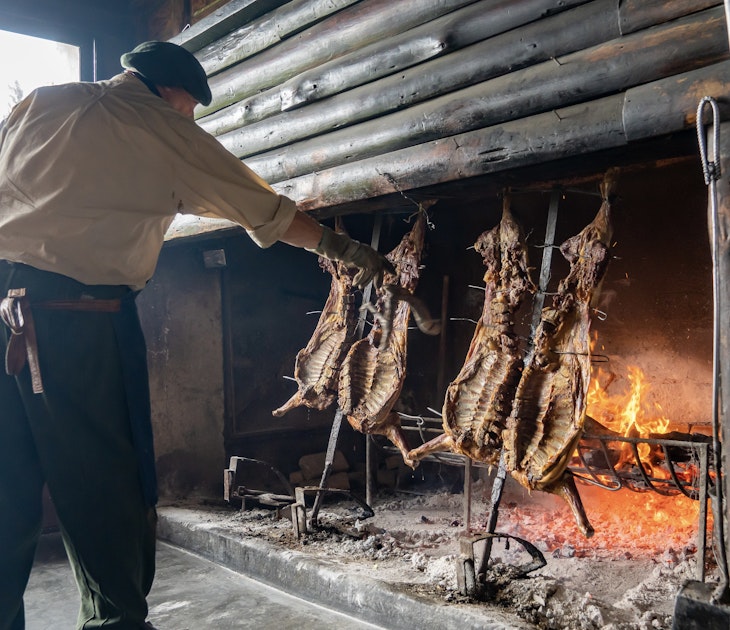
Tips & Advice
Mar 2, 2024 • 8 min read
There’s more to Argentinian cuisine than steak and malbec (though those are both great). Here’s our guide to Argentina’s best food and drink experiences.

Jan 23, 2024 • 4 min read

Jan 17, 2024 • 8 min read

Dec 1, 2023 • 6 min read

Nov 18, 2023 • 7 min read

Oct 18, 2023 • 5 min read
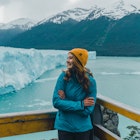
Sep 26, 2023 • 7 min read
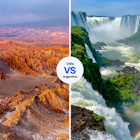
Sep 21, 2023 • 7 min read

Aug 20, 2023 • 8 min read

Aug 3, 2023 • 7 min read

The Best Time to Visit Patagonia According to an Expert
By Author Steph Dyson
Posted on Last updated: 8th November 2023
The wild and barren yet beautiful nature of Patagonia has never failed to enchant travelers from all over the world. It is, after all, a region unlike any other.
However, as most residents of Patagonia will likely tell you, it’s possible to experience all four seasons in one day here, thanks to often unpredictable weather conditions. I’ve been sunburned in late winter and soaked to the skin in mid-summer: the only thing you can rely upon in Patagonia is that there are never any guarantees!
Add into the mix this region’s increasing reputation as one of the most exciting adventure travel destinations in the world – and the number of tourists this brings – and it’s essential to consider when is best to visit Patagonia.
I’ve traveled here in many different months of the year and explored some of the remotest parts of the region as part of my research for the Moon Chile guidebook.
So let me guide you through the region – and ensure that your trip to South America’s southern frontier is unforgettable!
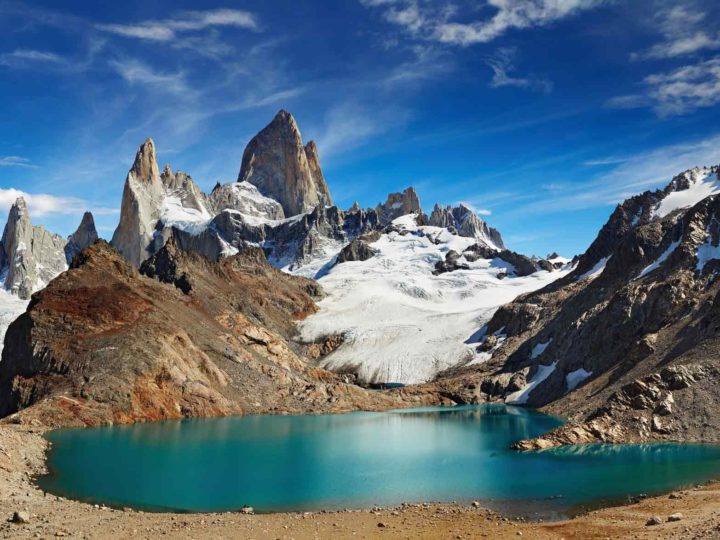
Click to navigate this article:
Patagonia’s climate month by month
- January: During this peak season, it’s best to visit a more secluded area of Patagonia, such as the Chilean side of Tierra del Fuego. Another way to explore the region is to cruise through the Patagonian fjords. El Chaltén and El Calafate in Argentina are also great alternatives during this month, while Antarctica is at its busiest.
- February: Chilean Tierra del Fuego is still the best option for the second month of summer’s peak season. Or go further south for extreme adventure in Puerto Williams or into Antarctica, where it’s peak whale-watching season.
- March: Drive down for a scenic road trip on the Carretera Austral . As summer ends, Torres del Paine is best during this month for fewer crowds, or go to Bariloche for hiking in Argentina’s most splendid national park.
- April: Visit Ushuaia and Tierra del Fuego National Park in Argentina on earlier dates for the best wildlife experience. A road trip through the Carretera Austral is another excellent option.
- May: Most tourist facilities begin to close, but you can still visit the Perito Moreno Glacier in El Calafate, which should be empty of crowds.
- June: Visit Ushuaia for the ten-day winter solstice celebration.
- July: Although the peak of winter offers challenging weather conditions in Patagonia in July, Torres del Paine is open year-round and accessible to more intrepid travelers with a guided tour.
- August: Despite the peak winter crowds, now is the time to hit the slopes at the world-famous ski resorts of Bariloche.
- September: As the snow piles up and the peak season winds down, this is the best month to visit Bariloche, the winter wonderland of Patagonia.
- October: Go to Ushuaia and Tierra del Fuego National Park in Argentina later in the month for the best wildlife experience, like spotting penguins.
- November: The road trip along the Carretera Austral road trip is best to take this month, while secluded Puerto Williams awaits with its challenging trails. You can also cruise through the Patagonian fjords, while the season for cruising to Antarctica begins as the sea ice starts to break up around the White Continent. Expect pristine snow and plenty of icebergs.
- December: Expect settled weather, fewer crowds, and the best hiking conditions in Torres del Paine, El Chaltén, and El Calafate before the peak summer season arrives. The season for Antarctica cruises hits full swing, with 24-hour sunlight and the arrival of penguin chicks.
The four seasons of Patagonia
The best time to visit Patagonia depends on what you’re trying to get out of your trip – and it’s certainly a location that experiences all four seasons.
Spring (September to November)
Spring brings with it fewer visitors, an increase in accommodation options, and comfortable trekking conditions.
If you’re planning on hiking in Torres del Paine in September, you will need to be accompanied by a licensed hiking guide (but it’s worth it: I loved being one of the only people in the park!). This is the second quietest season in Patagonia, so it’s a brilliant time to visit if you want to see the region in its quiet splendor or want to hike up to the torres (towers) of Torres del Paine at dawn (which, in winter, can be as late as 7am, but in summer, it can be as early as 4am).
Because of the lack of footfall and vehicles in the region during these months, it’s also the perfect time to spot Patagonia’s most acclaimed wildlife, which includes everything from guanaco and rhea to condors and – my personal favorite – pumas.
October onwards is also a great time to visit the northern part of Chilean Patagonia: the Carretera Austral. While this part of Patagonia doesn’t get anywhere near as busy as the locations further south, October is still a good time to beat the inevitable increase in tourists that the summer brings.
During these spring months, highs average around 16°C (60°F) and can drop to 3°C (37°F) at night – so bring plenty of layers, including thermal underwear if you plan on camping in the national park and a three- or four-season sleeping bag.
Summer (December to February)
This is the peak time for tourism, and many accommodations sell out ahead of time (so make sure to book early – at least three months in advance, or for the W, five or six is best). Prices are also more expensive, particularly around Christmas and New Year, but everything is open and all tours are now running.
Torres del Paine National Park is at its busiest, with dawn much earlier – so if you’re planning on hiking up to the torres (towers) from Torres Central (four hours) or Chileno (two hours), then you can expect an early start.
Temperatures hit 20°C (68°F), and drop to 8°C (46°F) overnight, while winds can reach up to a whopping 120 km/h (74 mph) – meaning the weather can actually be much less stable than in the rest of the year. As a result, you’ll want plenty of layers for when it gets cold or hot (both are a possibility!), plus a waterproof jacket and trousers.
Autumn (March to May)
The second shoulder season, and arguably the most beautiful of all, autumn sees the high visitor numbers begin to dwindle – just like the temperatures, which drop to highs of 13°C (55°F) during the day and -3°C (27°F) at night. The trees across the landscape are by now changing color, and while the weather can be unpredictable, the fall colors make it worth the risk.
In Torres del Paine, the O Circuit closes to hikers at the end of March, while the W may stay open a few weeks longer – although, this decision is often made last minute. From mid-April through May, you’ll need a licensed guide to do the W trek or any of the day hikes and many of the hotels, restaurants and tour operators will begin closing for the season.
Winter (June to August)
In winter, most accommodations, restaurants and tours close – which also means a huge decrease in the number of tourists.
If you choose to visit Torres del Paine, you’ll need to have a licensed guide with you and be aware that the O Circuit is completely closed to hikers. The W is only possible if you’re hiking with a local tour operator and you’ll typically have to camp as the refugios will be closed.
While it’s more expensive to visit in the winter, the national park is truly spectacular – with plenty of snow and a stillness that comes with there being very few other visitors.
Other national parks in the region tend to be fully closed for the winter, with trails in Parque Nacional Los Glaciares in El Chaltén, Parque Nacional Tierra del Fuego near Ushuaia, and those along the Carretera Austral often closed due to snow. While it theoretically is possible to visit during these months, you may find it impossible to do any hiking – and, for safety reasons, it’s sensible to hire a local guide to ensure you don’t stray off the paths.
Pack your thermals and warm layers, as temperatures average around 8°C (46°F) and drop to -3°C (27°F) at night.
Each part of Patagonia has its own climate and high season, so read on as I go through the best time to visit each region.
Planning Your Trip to Patagonia?
Save time, stress & money with a customized travel itinerary planned for you by a Patagonia expert
What conditions can you expect in different parts of Patagonia?
The geography of Patagonia goes some way in explaining its differing climate.
The Carretera Austral is typically wet and humid because of both the westerly winds and the fact that it captures the rain before it hits the Andes. It’s also much further north than Southern Patagonia (where you’ll find El Chalten, El Calafate, Puerto Natales, and Ushuaia), which, whilst it can still be cold due to its latitude, can get quite warm in the summer.
The Argentine side of Patagonia, meanwhile, is much drier as the Andes stops it from receiving much rain. As a result, much of the terrain on the Argentine side is a lot less exciting than on the Chilean side – so, if you’re looking for lush forests and glaciers, the Chilean half of Patagonia or on the very far western edge of Argentine Patagonia where it meets the Andes is the place to go.
Different parts of Patagonia are also busier than others. The main rule of thumb is that Southern Patagonia (Torres del Paine, El Calafate, El Chalten, and Ushuaia) are the most visited. Other places, such as the Carretera Austral annd Puerto Madryn are much quieter because they’re harder to get to.
Let me go into more detail about each of the destinations.
Torres del Paine National Park (Chile)
With multiple routes to choose from and breathtaking sights to see, this national park in the southern part of Chile is the ultimate trekking destination in Patagonia. It is so popular that it is packed during the peak months of January and February, although it’s actually accessible throughout the year.
The best time to visit Torres del Paine – and the nearby town of Puerto Natales – is between October and April.
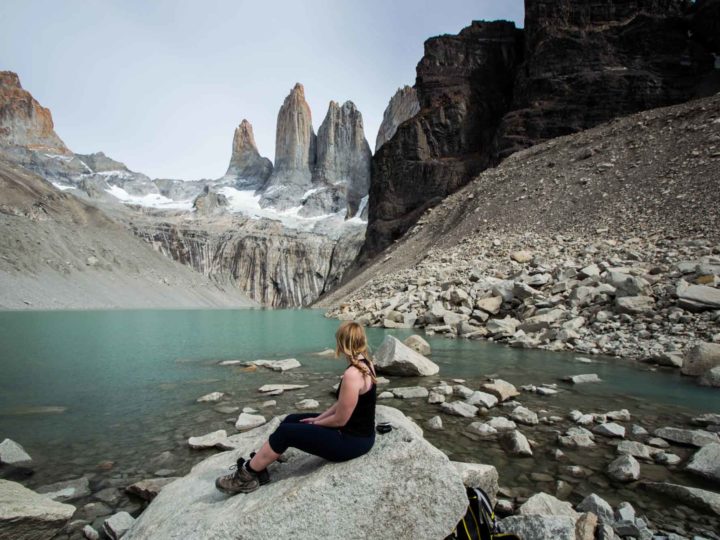
Torres del Paine from October through April
Though open year-round, self-guided activities – such as hiking the W trek without a tour – are only allowed during this period. This is also the peak season when all facilities are accessible.
From October to April, the weather in Torres del Paine is mostly mild: between a high of 18 o C (64.4 o F) and a low of 4 o C (39.2 o F). During summer (December to March), it is drier and warmer. However, you should not rule out rainy and windy days, which are common in this region.
Torres del Paine in winter
Due to the harsh conditions, you need to arrange a guided tour if visiting outside of these months. Expect snowy and windy weather from June to September, where the temperature often drops below freezing.
To avoid this, visit Torres del Paine in the off-peak month of May with a local guide. Though the weather can be cold, the scenery is generally stunning, and day hikes for all abilities are available.
Ironically, winter in Torres del Paine National Park is often less windy than in the summer months, and while it’s often very chilly, with some luck you can get plenty of bluebird days.
El Chaltén and El Calafate (Argentina)
Overlooking Los Glaciares National Park, El Chaltén is a summer destination. Experience the best time to hike in Patagonia here from October to April. If you are visiting Torres del Paine, stop by El Calafate first, where you can find the remarkable ice giant, Glacier El Perito Moreno , just a short distance from town.
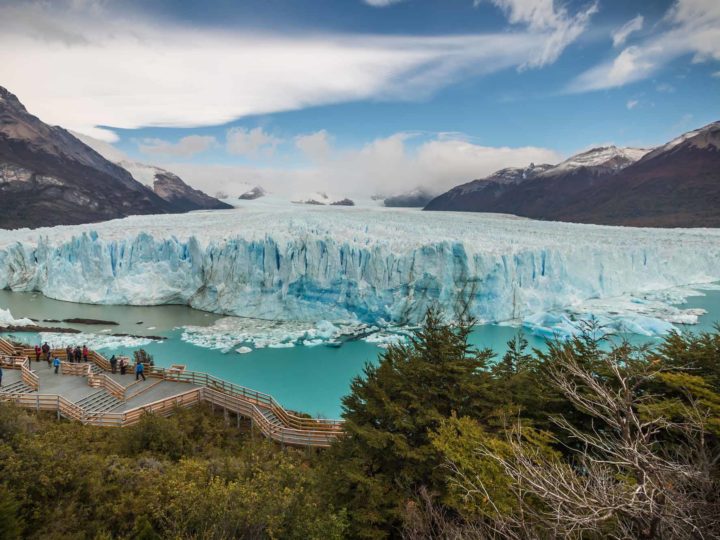
El Chaltén from October through April
Summer days in El Chaltén are perfect for self-guided hiking and trekking. All you need is this itinerary for one or two weeks in Patagonia , and you are good to go. The daytime temperature stays between 7.5 o C and 19 o C (45.5 o – 66.2 o F).
That said, you should still pack warm clothes as nights can get as cold as 5 o C (41 o F). The warmest month is January, which is also the height of the peak season, so opt for the shoulder months of November, December, and March for world-class hiking without tourists.
El Chaltén in winter
El Chaltén is open all year round, even during winter (from June to September) when the days are short. Most tour facilities are closed, but hotels and stores remain open. Since self-guided activities are not allowed during this time, you need to sign up with a tour provider to explore this region. If you don’t mind the colder days – averaging 4 o C (39.2 o F) – visiting El Chaltén in May would be best.
Ushuaia and Argentine Tierra del Fuego (Argentina)
If there is any place you can call at the edge of the world, this is it. Located off the southernmost tip of South America’s mainland, the Tierra del Fuego archipelago offers many outdoor activities, including the brilliant hiking destination of Tierra del Fuego National Park , and is one of the best destinations to explore in Argentine Patagonia .
Though this region has all four stages of the Patagonian seasons, the temperature stays around 0 o -10 o C (32 o -50 o F) year-round.
With that said, the best time to go is from the end of October through early April when the weather is better. If this is your first visit to Ushuaia or any area within Tierra del Fuego, this extensive 15,000-word guide on planning a trip to Patagonia should be helpful.
Ushuaia from late October through early April
Spring through to autumn is the best time to visit Ushuaia, although you can expect flurries of snow at the start and end of this period. Experience warmer temperatures with less rainfall and longer days – up to 17 hours of sunlight in total. Usefully for those seeking to travel around the region, this period is when all the bus routes are open and it’s easiest to get to and from Ushuaia.
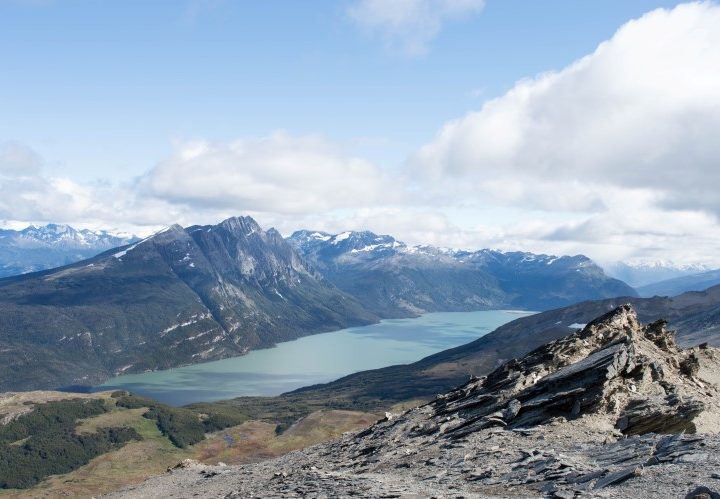
The peak of summer – January to February – is also the high season. Therefore, the best time to visit Argentine Patagonia is in December or March when the weather is cooperative, but places – such as one of Argentina’s best national parks , Tierra del Fuego – are not packed with tourists.
But if you are here for the wildlife, aim for the end of October or early April, when you can spot species unique to this area, from terrestrial mammals – such as guanaco and Andean fox – to austral parakeets and Andean condors. Keep in mind that Patagonia’s weather in April is more wet and windy than in the summer months.
Ushuaia in winter
Ushuaia celebrates the winter solstice with a three-day festival in June, while music and shows follow for up to 10 consecutive days in June. As a result, you may find hotels fully booked around this time, even though it is in the middle of the low season.
The Carretera Austral (Chile)
Bearing the name “the Southern Highway,” the Carretera Austral spans 1,240 kilometers through Chilean Patagonia, from its northernmost point at Puerto Montt to Villa O’Higgins in the south.
Surrounded by stunning scenery, it has been dubbed Patagonia’s most magnificent road trip . The best time to go to Patagonia along this scenic route is between November and April.
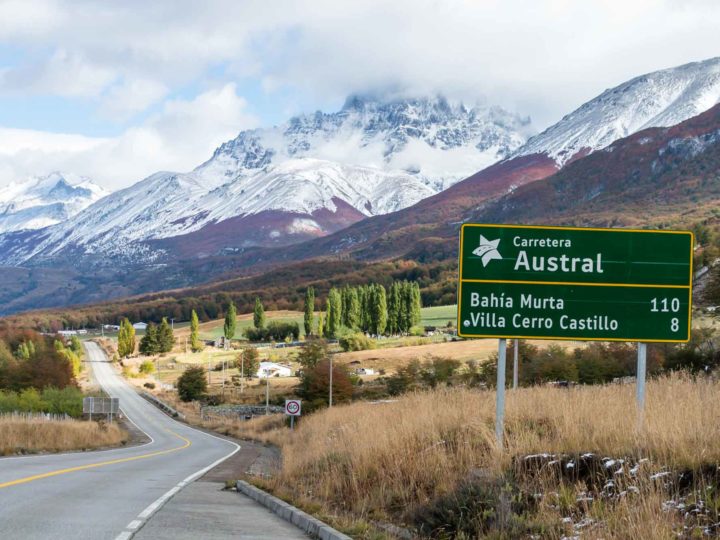
The Carretera Austral from November through April
Some of the best Patagonia weather is in November, with summer just around the corner. The warmest and driest time is January and February. As a result, these months are also the peak season when all tour operators are open, and hotels are usually packed.
Avoid visiting Carretera Austral between May and October. As it’s the off-peak season, these months can be dangerous for driving, and some roads are impassable in fall and winter. Also, bus routes are usually not available.
Keeping this in mind, the best months to visit off-peak are the shoulder season months of November (as spring is ending) or March and April (right at the end of summer) when it is not so crowded, and the weather is good for the most part.
Regardless of which month you choose, prepare yourself with car rental info and road trip itineraries for Patagonia to ensure your safety and comfort.
Bariloche (Argentina)
If Patagonia winter is what you are after, Bariloche is the region to visit. With up to two meters of snow coverage, this is indeed the winter wonderland of Patagonia. For the best winter activities, aim to visit between July and September. However, in the Austral summer, it’s also a key hiking destination.
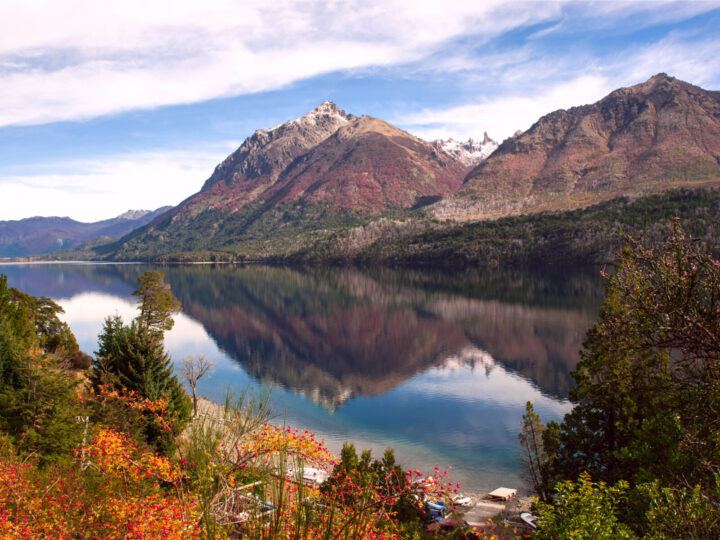
Bariloche from July through September
Patagonia winter truly begins in July, when the ski resorts are fully operational. During the day, average temperatures sit at 4 o C (39.2 o F), though it will feel colder when it rains. The largest downpours are usually around August. September is drier, which makes it the best time to visit Bariloche.
During this month, the temperature is slightly warmer (at 7 o C or 44.6 o F on average), while the snow coverage at the resorts is at a maximum.
Though most roads and walking trails are covered in snow – which means, as a result, hiking and trekking activities are not available – you will not have a hard time accessing the ski resorts from the Bariloche airport via taxi, bus, or rental car.
Bariloche from December through March
For those looking for the best time to hike in Patagonia, don’t exclude Bariloche. In fact, do include it! As the snow starts to melt, spring takes over the once-barren landscape. The temperature can reach 20 o C (68 o F), and trails are open, including the striking mountain range of Nahuel Huapi, which offers dazzling views of Bariloche and the lakes beyond.
If you would like to avoid the peak season, March is your best option.
Chilean Tierra del Fuego (Chile)
Further south of Torres del Paine, you’ll find the Chilean part of Tierra del Fuego . Unlike northern Chilean Patagonia, this region offers dramatic natural landscapes where few tourists ever venture – despite it being one of Patagonia’s most incredible places to visit .
Summertime from December to March is the best time to visit and experience the stark natural beauty of this truly remote hinterland.
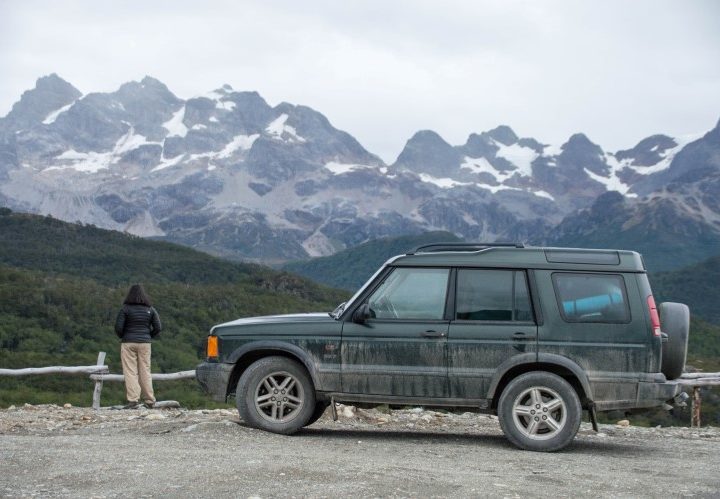
Chilean Tierra del Fuego from December through March
The region’s low population is one of the main reasons behind its quiet surroundings. Another reason is that it’s very difficult to access; as a result, avoiding peak season is not an issue. To get here, you’ll need to rent your own 4×4 and make careful plans for accommodation and fuel.
Download our one-month Patagonia itinerary for expert guidance for planning a trip to this part of the region.
Since you don’t have to worry about running into a pack of tourists, anytime between December through March is an excellent time to visit Chilean Tierra del Fuego; after this and road conditions can become unsafe. So go ahead and visit during the peak season of Patagonia in January and February.
While there aren’t many tourist facilities, those that do exist are open, the region’s treks are accessible, and you can be guaranteed a trip far beyond the beaten trail.
You need to keep in mind that this region is not for novice adventurers, and we highly recommend you look into our travel planning services to get you started.
Puerto Williams
Exploring South America’s southernmost town is not for the faint-hearted. Puerto Williams lies on a wind-swept island with 150 kilometers of challenging trails. Though there is no drastic temperature change throughout the year, summer is still the best time to visit for less rainfall.
Puerto Williams from November through December or February through March
The best time to visit Patagonia for a wider range of activities is, without a doubt, the summer. Summer in Puerto Williams runs from December through March. However, you may want to skip January as it is the peak of the tourist season and has the greatest chance of rain.
Outside of these months, Puerto Williams’ trails are not accessible. Even with the mercy of summer, exploring with an experienced group or a local tour guide is highly recommended. There is no sugar-coating it; these trails are tough.
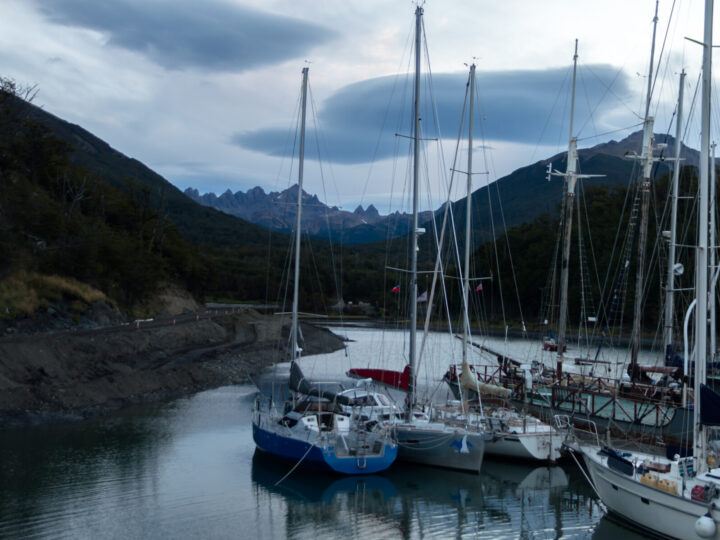
The temperature during summer is around 5 o C to 13 o C (41 o – 55.4 o F). To make your hike easier, it’s best to go during the driest summer month, February.
If you prefer avoiding peak season, late November is your next best option. These months’ conditions also guarantee a smoother boat trip aboard the Yaghan ferry , which is one of the best ways to get to Patagonia .
Cruising into the White Continent is the stuff of dreams for most adventurers. While you can take a flight from Punta Arenas in Chile directly to Antarctica, most opt for the more scenic choice: a small-ship expedition cruise from Ushuaia (Argentina).
There are plenty of different operators to choose from, with some incorporating the Falkland Islands and South Georgia into their trips (known for their remarkable abundance of wildlife, including penguins, seals, and marine birds), while others head into the Polar Circle to explore the lesser-visited part of the Antarctic peninsula.
Looking to head to the White Continent? I highly recommend the brilliant Swoop Antarctica. Their staff have extensive, first-hand experience of sailing to Antarctica and, because they sell cruises for all the well-known companies, they can give you handy, impartial advice for choosing the one that best suits you. What’s more, they specialize in small ship expedition cruises, which means you’ll be allowed to get off the boat at every stop on the itinerary (which is not the case for large ships!) and you won’t pay a cent more by booking through them rather than directly with the cruise company themselves. Ready to be inspired? Check out their classic cruises to the Antarctic Peninsula , or their more unusual trips to wildlife-rich South Georgia and the Falklands , or go further than most on a cruise to the Antarctic Circle .
Antarctica from November through March
Sea ice prevents visitors from reaching Antarctica outside of the brief months of November through May. November is perhaps the best month to visit Antarctica if you’re a photographer , as it is the start of the season and landscapes remain pristine – there have been no tourists to churn up the snow yet. Icebergs calving off the sea ice are also still around, making for truly sublime scenery.
December through January see the lion’s share of the tourists arrive and it’s also an easier time to visit as some of the snowbanks that make trails challenging have started to melt. You’ll also begin to see chicks hatching during the final weeks of December, although this peaks during January – the month that also sees the most settled weather in Antarctica.
If you want to catch sight of the humpbacks and orcas that have traveled to these waters, February is the best month – although expect the once-white snow to have turned mushy and brown underfoot thanks to visitors and the guano of the breeding penguins.
At the tail end of the Antarctica season is March, which is peak whale-watching season. During these final few weeks of travel to Antarctica being possible, you might even catch some snow as the cold weather draws back in for the winter.
We’ve gone into this topic in much more detail in this article about when to visit Antarctica – so head there for to learn more. You can also read our roundup of the best Antarctica books for inspiration!
Patagonian Fjords (Chile)
Exploring the narrow ocean channels that sit between the winding fjords of Patagonia is best done on a cruise or cargo ferry.
Ferry operators such as Australis are available with four-day to one-week excursions from late November through March, which you can book in advance, although the cargo boat from Punta Arenas to Puerto Williams is far cheaper and offers a similar route.
Patagonian Fjords from November through March
From the end of spring and throughout the summer is when to visit Patagonia on a ferry. Expect warm days with an average high of 20 o C (68 o F) and a low of 6 o C (42.9 o F). Since you will be on a ship, avoiding the crowd is not an issue, but you can expect boats to be booked up well in advance.
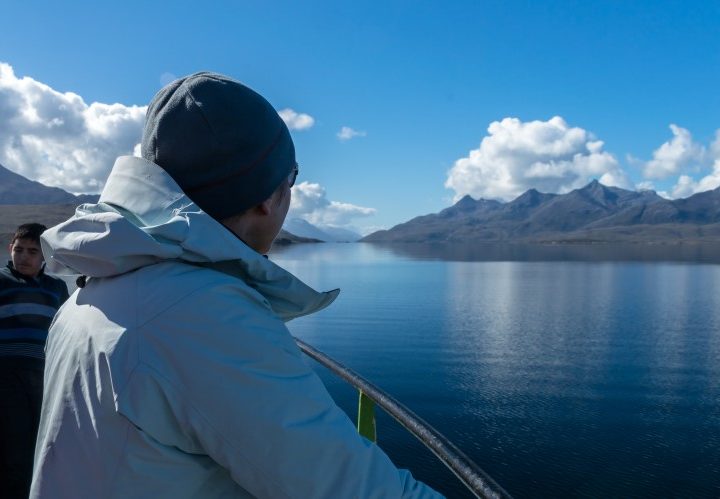
One of the most common ferry rides along the Patagonian fjords is accessible from Puerto Montt, the southernmost major city of Chile. Regardless of what they advertise, these vessels are usually cargo ships that also take passengers. One of the best providers is the Navimag. Read this review of the Navimag Ferry ride from Puerto Montt to Puerto Natales to better understand what to expect from this Patagonian fjords trip.
Alternatively, go even more remote with a journey from Puerto Montt to Puerto Williams aboard the Yaghan ferry . Also a cargo ship, this boat takes you through Glacier Alley, a channel where tidewater glaciers cling to the sides of the fjords and feed slowly into the water.
After 32 hours, and frequent sightings of penguins, seals, and even whales, you’ll dock at Puerto Williams, the southernmost settlement on the planet.
Outdoor activities in Patagonia and when to do them
Camping in Patagonia truly is spectacular – but be mindful of when you choose to go.
Spring (September to November) tends to bring cold but generally clear weather; you will need thermals and a four-season sleeping bag if you plan on camping during these months. Most national parks and campgrounds don’t necessarily open until October (Torres del Paine) or November, so bear this in mind when planning your travels. This is the lower season, so there is less competition for camping spots along the W trek in Torres del Paine until the week of Thanksgiving in November.
Summer (December to February) is warmer, but also the windiest and busiest time of year – especially in Torres del Paine National Park, and Los Glaciares National Park (Argentina). With this being peak season, make sure to book your camping pitch in advance to avoid disappointment. For the W and O treks in Torres del Paine National Park, you’ll need to book at least five or six months ahead if you plan on hiking during these months.
The weather starts cooling off in autumn (March to May), but is otherwise generally relatively settled. You might experience more rain during this season, but the parks are quieter. Bear in mind many trails start to close at the end of April (the O and the W), while other campgrounds may close for the winter if early snowfalls.
Most camping spots close over winter (June to August), along with many hotels, tour agencies and restaurants.
Watersports
You’ll be spoilt for choice when it comes to water sports in Patagonia.
In Northern Patagonia
On the banks of Chile’s second-largest lake, Lago Llanquihue and with views of Volcán Osorno and Volcán Calbuco, Puerto Varas (Chile) is the most vibrant and most visited of the towns in the Lakes Region. It’s a favorite amongst adventure travelers, with one of the main draws here being its access to an abundant supply of lakes and rivers. Kayaking on nearby lakes and rivers is at its best between October and May, after which the winter weather sets in and it can be very cold to be in the water.
Further south in Puerto Rio Tranquilo (Carretera Austral, Chile), between January and April, you can kayak through the Capillas de Mármol (Marble Caves), which are a collection of rainbow-hued rock caves.
In Southern Patagonia
In Torres del Paine (Chile), kayaking only takes place during the main tourist season, which extends from October through April. Wind speeds tend to pick up in January and February, which can make conditions on Lago Grey – the main location for kayaking – more challenging.
The story’s the same across the border in Parque Nacional Los Glaciares, with kayaking in front of Argentina’s most famous glacier, the 25,000-hectare Glaciar Perito Moreno, possible during the same months.
Further south in Punta Arenas (Chile), Solo Expediciones also have a truly unique option for kayaking with the whales that swim to Parque Marino Francisco Coloane during the summer to feed. December through May are the best times to see the whales, however, local operators such as Solo Expediciones only run these tours between December and March.
The Chilean Lakes District isn’t just known for its kayaking opportunities. In fact, the most popular watersport in Puerto Varas, is white water rafting. Operators tend to only offer rafting between August and May, however, as the sunshine begins to melt the icepack in the Andes above, the rivers grow, reaching their peak in around November and December – which many therefore consider the best time to raft in the area.
It’s a similar story a little further south, where the Río Futaleufú has some of the most exciting Class III-V white-water rapids in the world. The water tends to be at its peak here around October, with the rafting season only running from this month until March.
Both the Chilean Lakes District and the Aysén region further south are ranked among the most coveted destinations on the planet for fly fishing, thanks to astoundingly pure rivers and lakes ringed by virgin terrain of snowy peaks, lush native forests, and few other anglers.
November and December are best for fishing streamers, large dry flies and nymphs for large trout, while January through April is best for fishing dry fly patterns of all sizes and styles. Fishing lodges tend to only operate between these months.
Trophy-size fish are the norm, from 80-centimeter brown trout to 20-kilo chinook salmon. Fishing is catch-and-release, and the main season is October-April.
Photography
For the shutterbugs, late March and April are the best times for autumn colors in Patagonia, making them the months when photographers around the world descend upon the region. My good friend Kevin (aka Shutter Safari) has a Travel Guide and Map from his time shooting in Patagonia and features one hundred must-visit locations for the best photography opportunities throughout Patagonia. It’s a great book for planning your photography trip and gives advice on capturing the best images across the region’s dramatic landscapes.
Booking accommodation in Patagonia
Prices can triple between December and early February, and sell out in advance, so make sure you book early if traveling during these peak months.
Many hotels shut down between the end of April and August (or even sometimes September), so bear this in mind when planning your trip. September and October are a good time to visit Torres del Paine and Southern Patagonia, as hotels are at their cheapest, and rarely booked up – although you will have to factor in the additional cost of hiring a guide if you plan on hiking in the area.
Booking tours in Patagonia
For tours across Patagonia, I recommend Chile Nativo – mention Worldly Adventurer and you’ll get a 5% discount on your tour.
Alternatively, if you’d like to arrange a 19-day self-drive tour of the Carretera Austral , with both guided and self-guided adventures, I recommend EcoChile Travel, one of my partners in the area. Wave goodbye to the planning and logistics that can come from having to do it all yourself, and let the experts do it for you. Get a 5% discount by mentioning Worldly Adventurer when you book.
FAQs about Patagonia
How many days do you need for patagonia.
Ideally, you need a minimum of one week to explore Southern Patagonia and cover the region’s highlights: Puerto Natales, Torres del Paine National Park, the Perito Moreno Glacier , and the hiking trails of Los Glaciares National Park near El Chaltén.
If you’ve got two weeks, you could add in Ushuaia and Bariloche on the Argentine side, or spend the entire time in Chilean Patagonia along the Carretera Austral before heading down to hike in Torres del Paine. As this region is vast and trying to cover great distances can be laborious, it’s better to slow down and choose a handful of places in which to spend your time.
Is Patagonia better in Chile or Argentina?
Chilean Patagonia has a wider variety of ecosystems than Argentine Patagonia: think the lush, temperate rainforests and glaciers clinging to mountains of the Carretera Austra l; the icy fjords packed with marine wildlife along the west of Chile; and the snow-topped mountains lined with southern beech forests of Torres del Paine National Park . As a result, if you want to adventure into a range of different environments, then Chilean Patagonia is a better match.
The Chilean peso is also significantly more stable than the Argentine peso; rampant inflation in Argentina is causing tours, accommodation, and dining to be extremely expensive. That said, Argentina is home to its own incredible sights, including the iconic Monte Fitz Roy near El Chaltén, the vast Perito Moreno Glacier near El Calafate, the penguin colonies of Puerto Madryn, and the lake-stippled landscapes of Bariloche.
When should I go to Argentine Patagonia?
The Patagonia travel season is short, with visitors only arriving in the region from late October through early April during the Austral summer. This is because of the cold, inclement weather that the Patagonian winter brings.
However, with December and January the peak season for visitors, it’s better to explore Argentine Patagonia during the shoulder seasons: October through November and late February through March. Prices will be cheaper, accommodations easier to book and hiking trails quieter.
Is October a good time to visit Patagonia?
October marks the very start of the Patagonia travel season. Because it’s the tail end of spring, you might find that weather remains cold and there’s still a possibility of snow – although weather is so variable in Patagonia that there’s always a possibility of snow! That said, you can expect the landscape to be erupting in an ocean of flowers and greenery following its dormancy over the winter – making this a very beautiful season to visit Patagonia .
During the day, temperatures can peak at 14°C (57°F) before dropping to 1°C (34°F) at nighttime; you’ll want layers for the day and a warm, cozy sleeping bag for the night. However, as winds are at their strongest during the summer, you’ll likely escape the worst of Patagonia’s infamous gusts!
Saturday 6th of August 2022
Tierra del Fuego is in Argentina - IS NOT CHILEAN
Steph Dyson
Monday 8th of August 2022
Half of it is Chilean. Trust me, I've been there!
Argentine Patagonia Travel Guide
Courtesy of George Pachantouris | Getty Images

Best Times To Visit Argentine Patagonia
The best times to visit Argentine Patagonia are October through November (springtime in the southern hemisphere) and December through February (summertime). During these months, the weather is mild, and spectators can view natural attractions in their full splendor. You should make your spring and summer travel arrangements far in advance since visitors flock to Argentina for the optimal hiking conditions. Pack layers to combat Patagonia's heavy winds (especially if you're planning a visit to Southern Patagonia ). January and February draw the largest crowds, but October, March and April are also good times for sightseeing, boasting sunshine and temperatures in the 40s, 50s and 60s.
Weather in Argentine Patagonia
Data sourced from the National Climatic Data Center
Find Flight and Hotel Deals
Navigate forward to interact with the calendar and select a date. Press the question mark key to get the keyboard shortcuts for changing dates.
Navigate backward to interact with the calendar and select a date. Press the question mark key to get the keyboard shortcuts for changing dates.
Popular Times to Visit Argentine Patagonia
Tourism volume is estimated based on in-market destination search query interest from Google and on travel.usnews.com in 2015-2016. Hotel prices are sourced from a sample of U.S. News Best Hotels rates through 2015-2016.
Explore More of Argentine Patagonia

Things To Do

Best Hotels

You might also like

# 2 in Best Places to Visit in Spring

# 7 in Best Places to Visit in July 2024

Chilean Patagonia
# 2 in Best Places to Visit in Central and South America in 2023
If you make a purchase from our site, we may earn a commission. This does not affect the quality or independence of our editorial content.
Recommended
The 50 Best Hotels in the USA 2024
Christina Maggitas February 6, 2024

The 32 Most Famous Landmarks in the World
Gwen Pratesi|Timothy J. Forster February 1, 2024

9 Top All-Inclusive Resorts in Florida for 2024
Gwen Pratesi|Amanda Norcross January 5, 2024

24 Top All-Inclusive Resorts in the U.S. for 2024
Erin Evans January 4, 2024

26 Top Adults-Only All-Inclusive Resorts for 2024
Zach Watson December 28, 2023

Solo Vacations: The 36 Best Places to Travel Alone in 2024
Lyn Mettler|Erin Vasta December 22, 2023

26 Cheap Beach Vacations for Travelers on a Budget
Kyle McCarthy|Sharael Kolberg December 4, 2023

The 50 Most Beautiful White Sand Beaches in the World
Holly Johnson December 1, 2023

The 26 Best Zoos in the U.S.
Rachael Hood November 16, 2023

44 Cheap Tropical Vacations That Feel Expensive
Holly Johnson|Alissa Grisler November 10, 2023


- Saving Money & Budgeting
- Packing & Travel Gear
- Accommodations
- Transportation
- Safety Tips
- Long Term Travel
- South Africa
- Philippines
- Puerto Rico
- Czech Republic
- Israel and Palestine
- Mississippi
- North Carolina
- South Carolina
- New Zealand
- Travel Resources
- Must-Have Items
- Travel Inspo Books
- Why The Cure for Curiosity?

Best Time of Year to Visit Patagonia: Season by Season Breakdown
Julia June 14, 2023 Argentina , Chile 2 Comments
Trying to decide when to visit Patagonia? Find out the best time of year to visit Patagonia according to your interests in this deep dive of the four seasons.
Calling all adventure seekers and nature lovers! If you’re craving a rendezvous with the untamed beauty of Patagonia – in southern Argentina and Chile, you’ve come to the right place.
In this guide, I’ll walk you through the seasons in Patagonia, revealing the best time to visit this untouched land of amazing landscapes, dramatic mountains, and awe-inspiring glaciers. So, grab your backpack, strap on your hiking boots, and let’s dive into the best time to visit Patagonia!
Disclosure: Some of the links below may be affiliate links. At no additional cost to you, I may earn a small commission if you make a purchase.
Table of Contents
Spring in Patagonia
September – November
First and foremost, you have to remember Patagonia is in the Southern Hemisphere. This means spring arrives in Patagonia in September. During the spring months, September, October, and November, the region transforms into a beautiful paradise. Average temperatures linger around 41°F to 59°F (5°C to 15°C ), creating comfortable conditions for outdoor activities.
In Torres del Paine National Park, the iconic granite peaks of Los Torres stand tall against a backdrop of lush green valleys. Meadows come alive with wildflowers. Waterfalls cascade down cliffs, with their powerful waters fueled by the melting snow from the mountain peaks.
However, be prepared for the occasional spring rain shower. Patagonia’s weather is famously unpredictable, and spring is no exception. Make sure to toss a waterproof jacket into your backpack and embrace the chance of dancing in the rain, as it’s sure to happen during springtime in Patagonia.
Pros of Visiting Patagonia in Spring
- Vibrant colors: Spring in Patagonia bursts with colors as the landscape thaws out and comes alive with wildflowers and lush greenery.
- Mild temperatures: Spring offers comfortable temperatures ranging from 41°F to 59°F (5°C to 15°C), perfect for outdoor activities without feeling like you’re roasting or freezing. It’s the Goldilocks of seasons—just right!
- Fewer crowds: Spring is considered the shoulder season in Patagonia, so you can enjoy the beauty of Patagonia without bumping into selfie sticks and influencers at every turn. If you’re lucky, you might even have a trail or two to yourself!
Cons of Visiting Patagonia in Spring
- Unpredictable showers: Springtime in Patagonia has an mischievous side, occasionally surprising hikers with spontaneous rain showers. Embrace it, they will pass shortly.
- Less accessibility: Some trails and accommodations may still be closed or limited during the early spring season. If you go later in the spring, like November, things will be gearing up for high seaon in summer, so you won’t face the same challenge. But even in early spring, don’t worry – there’s still plenty to explore!
Summer in Patagonia
December – February
Summer in Patagonia—the pinnacle of outdoor adventure and exploration. From December to February, the region experiences long days and mild temperatures, ranging from 50°F to 68°F (10°C to 20°C). It’s the perfect time to set out on those bucket-list-worthy adventures that Patagonia is renowned for.
Head to the stunning Perito Moreno Glacier, where you can strap on crampons and walk on its icy surface, a once-in-a-lifetime adventure for sure. Hikers can tackle the famous W Circuit or the challenging O Circuit in Torres del Paine National Park which take multiple days to hike, with its towering granite peaks, glacial lakes, and sweeping vistas.
The abundant daylight hours offer ample time to explore the mesmerizing landscapes, but don’t forget to protect your skin from the intense Patagonian sun. Pack the sunscreen. Wear a wide-brimmed hat. Flaunt your stylish sunglasses in your vacation photos. Do what you must to revel in the endless adventures Patagonian summers have to offer.
Pros of Visiting Patagonia in Summer
- Endless adventures: Summer in Patagonia unlocks a treasure trove of outdoor activities. From hiking trails to cruising to glaciers and fjords, your options are as vast as the Patagonian landscapes. You’ll want to try everything!
- Longer days: Patagonian summers gift you with extended daylight hours, allowing you to squeeze in even more adventures. These extra hours magically added to your day allow all the more time for exploration and making unforgettable memories.
- Lively atmosphere: Patagonia comes alive during summer, buzzing with energy and travelers from around the world. You’ll encounter other adventurers with fascinating stories to share adding another layer of richness to your trip.
Cons of Visiting Patagonia in Summer
- Crowded trails: The popularity of Patagonia in summer means some trails may be busy. You may find yourself playing “Follow the Leader” instead of enjoying the serenity of hiking in nature. Just remember to bring your patience and consider less popular trails.
- Higher prices: With increased demand comes higher prices for accommodations and tours. You’ll want to have a little extra wiggle room in your budget, but don’t worry, there are still affordable options available with a bit of research.
Learn all about Hiking the W Trek East to West in Torres del Paine National Park
Fall in Patagonia
March to May
Patagonia’s autumn is another popular season for visiting as the landscape comes alive with fall colors. From March to May, average temperatures range from 41°F to 59°F (5°C to 15°C), creating a perfect time for hiking and immersing yourself in the region.
Autumn in Patagonia brings a blaze of red and orange to some of the local forests which contrast well with the crystal-clear lakes and mirrored reflections. But perhaps best of all, the popular trails become less crowded, allowing for more intimate encounters with nature.
Pack some extra layers to keep cozy during the evenings as the temperature does drop and be a bit chilly if you’re camping. Also, make sure to bring your camera to capture this amazing time of year in Patagonia. It really is one of the most beautiful seasons in the region.
Pros of Visiting Patagonia in Fall
- Stunning foliage: Autumn transforms Patagonia into a picturesque outdoor playground, with trees donning golden and fiery hues. It’s like walking through a real-life painting, with colors that will leave you breathless and your camera memory card begging for mercy.
- Tranquility: Autumn brings a renewed sense of serenity as crowds thin out, offering a more peaceful experience out in nature.
- Pleasant temperatures: As temperatures dip slightly to 41°F to 59°F (5°C to 15°C), you can enjoy comfortable hiking conditions without breaking a sweat.
Cons of Visiting Patagonia in Fall
- Variable weather: Autumn in Patagonia can be a bit of a diva, with unpredictable weather changes. Pack your layers and embrace the “dress for success, whatever the forecast” mantra. Add layers. Remove layers. You know the drill.
- Limited services: Some accommodations and facilities may start closing for the season as autumn progresses. It’s like trying to catch the last train home after a night out. Plan accordingly and book ahead to verify availability.
Winter in Patagonia
June – August
Winter in Patagonia brings a new chapter to life – a cold one. From June to August, average temperatures range from 28°F to 46°F (-2°C to 8°C), creating a playground for snow enthusiasts and photographers seeking winter wonderland scenes.
The Andean peaks show off their brilliant white coat of snow, transforming jagged cliffs and mountains and crystal clear lakes into a frozen wonderland. Winter is the perfect time to hit the slopes in one of the region’s renowned ski resorts, such as Cerro Catedral or Cerro Bayo, where you can carve your way through powder-soft snow and take in breathtaking panoramic views.
For photographers, winter in Patagonia presents a unique opportunity to capture surreal landscapes. The contrast of the snow against the dramatic mountain backdrop creates a visual that you’ll want to capture on film. From frozen waterfalls to icicle-laden trees, every corner of Patagonia becomes picturesque.
Embrace the cozy charm of winter by cozying up in a lodge with a crackling fireplace. Indulge in hearty Patagonian cuisine, savoring warm stews and hot chocolate. Don’t forget to pack your warmest thermals, waterproof boots, and layers to keep yourself toasty in the cool temperatures.
Pros of Visiting Patagonia in Winter
- Snowy landscapes: Patagonia in winter transforms into a magical wonderland with pristine white snow covering the rugged terrain. It’s a absolutely picturesque and worth coming for the views alone.
- Unique activities: Winter opens up a whole new world of activities in Patagonia, from skiing and snowboarding on the slopes to ice trekking across frozen lakes and glaciers.
- Cozy ambiance: The colder temperatures create the perfect excuse to indulge in cozy moments by the fire, wrapped in blankets, sipping on hot chocolate or local spirits.
Cons of Visiting Patagonia in Winter
- Chilly temperatures: Winter in Patagonia brings cold weather. Be prepared to bundle up like an expert winter fashionista. It’s like layering clothes to rival an onion, with the goal of staying warm while maintaining your mobility and not looking like a snowman yourself.
- Limited accessibility: Some remote areas and hiking trails may be inaccessible or closed during winter due to snow accumulation or weather conditions. If hiking is high on your list of priorities, this is the wrong time of year to visit Patagonia.
- Shorter daylight hours: With fewer hours of daylight, planning your activities becomes a delicate balance of timing and prioritization. Choose your daily activities wisely and make the most of the daylight hours available.
Explore More of Patagonia
Due to its extreme southern location, Patagonia experiences very distinct seasons. This means deciding when to visit Patagonia really matters. You’ll have to choose between blooming flowers, autumn colors, snow-covered landscapes, and more. Each season reveals a different side of this natural wonderland.
No matter when you choose to visit, Patagonia promises unforgettable moments, breathtaking scenery, and a truly unique trip. So, pack your bags, choose the Patagonian season that resonates with your adventurous spirit, and get ready to create memories that will last a lifetime in this captivating land at the end of the world.
Here are some additional posts to help you plan your time in Patagonia.
- Epic 2 Week Patagonia Itinerary: Travel Guide to an Outdoor Paradise
- 18 Best Things to Do in El Calafate, Argentina
- Where to Stay in El Calafate: Hotels for All Budgets
- Hiking the W Trek East to West in Torres del Paine National Park
- How to Book Campsites in Torres del Paine National Park
- Ultimate Guide to Visiting the Penguins of Isla Magdalena from Punta Arenas
Like this post? Pin it.

Other posts you might like
Great article! We’re hoping to make it there one day!
You would love Patagonia! It’s one of the most beautiful natural areas in the world… I’d put it up there with Banff/Jasper in Canada, the Himalayan Mountains in Nepal, and the south island of New Zealand!
Join the conversation Cancel reply
The Best Time to Visit Patagonia
:max_bytes(150000):strip_icc():format(webp)/Becker1-5b734a56c9e77c0025caddbd.jpg)
Along the southernmost tip of South America , where the Andes Mountains meet the desert highlands and the grassy plains, there is a place so remote, wild, and beautiful that hikers, backpackers, and climbers have been flocking to it for decades. Covering more than 400,000 square miles across both Chile and Argentina , Patagonia is an outdoor paradise unlike any other on the planet, making it a must-see destination for any adventure traveler.
There are plenty of reasons to visit Patagonia just about any time of the year. But if weather is your primary concern, you'll find the most stable and predictable conditions during the summer months of December through March. On the other hand, if you're looking to minimize the crowds as much as possible, and save a bit of money, than spring and fall may be your best overall bet.
The best time to visit Patagonia depends almost entirely on what you want to do when you get there—but no matter when you go, be sure to pack warm clothes, as well as rain jackets and pants, as the weather can and will shift unexpectedly at any time of the year in Patagonia.
Weather in Patagonia
The weather in Patagonia is known for being notoriously fickle all year round, although it is most warm and stable during the austral summer. In the Southern Hemisphere, that means late-December through late-March. During this time of year, the days are long, the skies tend to be clear, and rainfall is at a minimum. Strong winds are frequent during the summer months, however, so it is not uncommon for temperatures to feel colder than they are.
In the spring and fall—September through November and March through May, respectively—the days are noticeably cooler, and the chance of rain increases substantially. The winds aren't quite as strong as they are throughout the summer, but they are colder and harsher too. The chances of snow, particularly at higher altitudes, are a real possibility as well, especially in early-spring and late-autumn.
Of course, winter (June through August) is the harshest and coldest season of them all, bringing less predictable weather, freezing temperatures, and plenty of snow and ice. That said, however, the winds tend to be somewhat mild at this time of year, which helps to keep wind chill temperatures to a minimum.
The summer months are the busiest of the year, with tens of thousands of trekkers arriving from all across the globe. Thanks to its immense size, though, it rarely feels crowded in Patagonia, making it an excellent destination even at the height of the busiest travel season. Still, if you're looking to avoid potentially-crowded huts, lodges, or campgrounds, perhaps the shoulder seasons of spring and fall will be more to your liking. During those times of the year, the trails, lakes, and climbing routes tend to be far more empty, making it a good option for those looking for a bit of peace and solitude. Unsurprisingly, winter is the least-busy time of the year in Patagonia, with only the hardiest and most well-equipped adventurers making the journey.
Trail Closures
Patagonia is made up of Torres del Paine occupying southern Chile and Tierra del Fuego in southern Argentina. While those parks are both accessible throughout the year, winter snows and harsh conditions can close some of the best hiking trails and other attractions during that time of the year. Keep that in mind when planning your visit.
Outdoor Activities
As already noted, Patagonia is one of the best outdoor playgrounds on the planet, which is why it is such a popular destination for adventure travelers. Knowing which outdoor activities interest you the most will have a significant impact on when you should go. For instance, summer is probably the best time for hiking, backpacking, and climbing, three of the most popular outdoor sports amongst travelers. Naturally, winter is the best time for skiing and snowshoeing. At the same time, late-spring and early-summer are perfect for whitewater rafters and kayakers looking to take advantage of the melting snow. Spring and autumn are ideal for flat-water kayaking as well, thanks in part to the more-stable wind conditions.
Patagonia offers visitors a chance to spot some dramatic and unique wildlife, including guanacos, foxes, armadillos, deer, and even pumas. During the busy summer season, those creatures—especially the puma—may retreat from the more frequent foot traffic on the trails, making it much harder to catch a glimpse of them in the wild. If spotting wildlife is one of your main goals while in the area, consider visiting in the spring or fall when the creatures are much more common.
Coming in like a lion and out like a lamb, spring in Patagonia tends to start cold, but warm up as the weeks pass. Temperatures are typically in the upper 40s and low 50s Fahrenheit. At the same time, the average amount of precipitation is at its lowest point all year, even dipping below an inch of total accumulation during September. Nights can be a bit chilly, however, and the weather conditions can vary significantly throughout the day. The upside is, the number of visitors to the region tends to be small, prices are lower than during the peak season, and the wildlife starts to become much more active too.
Summer in Patagonia is highlighted by warmer days, cool nights, and a decreased chance of rainfall. Average daytime temperatures are usually in the low- to mid-50s F and the average annual rainfall above an inch each month. Strong prevailing winds, along with more crowds, can make conditions a bit less tolerable for some travelers as well, even though there is plenty of Patagonia to go around. This is also the most expensive time of year to visit the southern tip of Chile and Argentina.
Patagonia's fall starts warm and ends on the cold side, with the chances of snow increasing with each passing week. Rain is a real possibility in the early part of the season as well, with strong winds creating uncomfortable conditions for those who fail to pack the right layers. That said, there still tends to be more clear days than rainy ones, and the shifting colors of the season are stunning to behold. Smaller crowds also translate into more wildlife sightings on the trail, too, presenting photographers with the best opportunity of the year for capturing stunning photos.
The crowds are practically nonexistent during the Patagonian winter, making it a great time to visit for those who enjoy the cold and snowy conditions. Temperatures rarely climb above 40 degrees F during the day all season long, with the mercury dropping down to the 20s at night. It is not uncommon for a blanket of fresh snow to fall throughout the area, taking the already gorgeous landscapes to an entirely new level in terms of beauty. That said, many of the lodges and attractions close down for the winter months, which could limit your options on where to stay and what to do. Prices tend to be very affordable; however, provided you can find a place that will be open for you.
The best time to visit Patagonia depends on your travel desires. If weather is your primary concern, the most predictable conditions occur during the summer (December through March). If you're looking to avoid crowds and save money, spring and fall are your best bet.
There are two ways to fly to Patagonia. You can book a flight to Ezeiza International Airport in Buenos Aires, Argentina, and then take a hopper plane to your destination city in Patagonia. Or, fly into Punta Arenas Airport in Chilean Patagonia, and cross the border by car.
A direct flight from Atlanta to Buenos Aires is nine hours and 35 minutes. From New York's JFK, the flight time is 10 hours and 35 minutes. And from Dallas, the flight time to Buenos Aires is 10 hours and 20 minutes.
Nat Hab. "Weather & Climate in Patagonia." Retrieved February 6, 2021.
Your Trip to Argentina: The Complete Guide
The Best Time to Visit Boston
The Best Time to Visit Morocco
The Best Time to Visit Cape Town
Weather in Las Vegas: Climate, Seasons, and Average Monthly Temperature
The Best Time to Visit Munich
The Best Time to Visit Japan
The Best Time to Visit Kauai
Weather in Argentina: Climate, Seasons, and Average Monthly Temperature
The Best Time to Visit Alaska
The Best Time to Visit Argentina
The Best Time to Visit Chile
The Best Time to Visit Buenos Aires
Weather in Alaska: Climate, Seasons, and Average Monthly Temperature
Weather in Chile: Climate, Seasons, and Average Monthly Temperature
Weather in Buenos Aires: Climate, Seasons, and Average Monthly Temperature

Best time to visit Patagonia
Do you know what is the best time to visit Patagonia? Well, it’s not just a specific period. It all depends on what you want to do, your budget and what kind of trip you want. The best time to travel to Patagonia is from October until the end of March. Continue reading if you want to know more about getting the best price for your accommodations and when is the high-season in Patagonia.
Read also: getting from El Calafate to Torres del Paine (all transport options)
The best time to travel to Patagonia is from October until the end of March. During those months it will be spring, summer and just the start of autumn in Patagonia. Patagonia is known for its strong winds and chiller summers than the Northern parts of Argentina and Chile. For example, in Ushuaia – the most Southern town in the world – has a temperature of around 15 degrees Celcius / 59 Fahrenheit in summer (December / January). Just perfect for a hike and exploring the area. However, in Bariloche – a bit higher to the North – there it is around 23 Celcius / 74 Fahrenheit in summer.
Our preference goes out to October till mid-November. At that time it is spring in Patagonia. The flowers are in bloom and you can see nature come out of its winter sleep. Just perfect. Also, the snow is fresher and meaning that the landscape has that little bit of idyllic view.
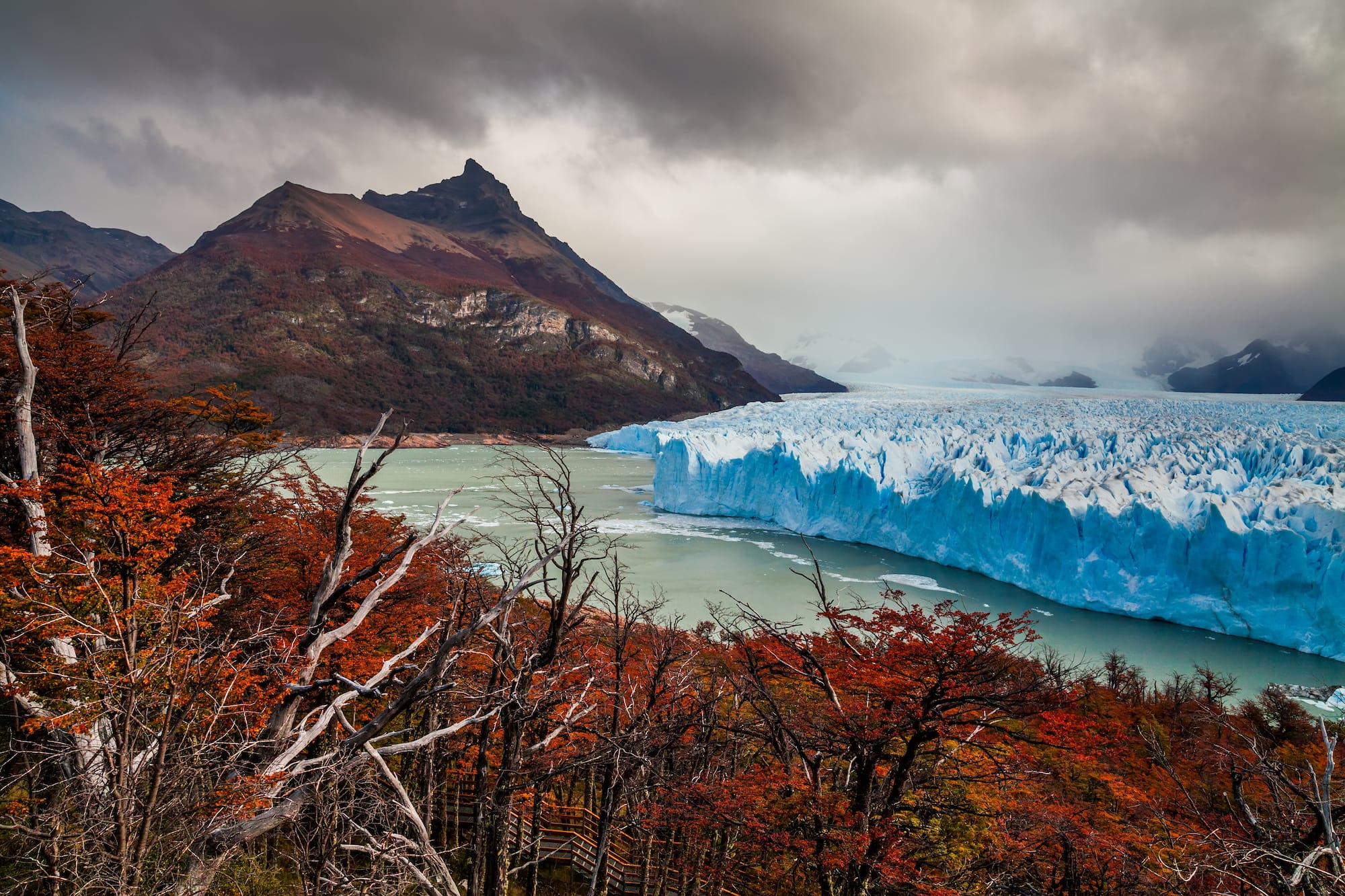
Secrets to choose the best months
Choosing the best time to visit Patagonia is also a matter of saving money. Prices of accommodations are at their peak prices from November till February. So, if you want to travel cheaper you should choose October or March. It can save you up to 30% per night.
Just to know that summer holidays for residents in Argentina and Chile are in December and January. And Argentinians and Chileanian people do like to travel in their country. So, if you want to travel in a calmer period. Don’t travel to Patagonia in December or January.
Read also: Whale watching in Argentina (Patagonia). When is the best moment?
The best weather channels for Patagonia
Giving an overview of the climate in Patagonia is difficult. Because the region is enormous. Climate is so different from North till South. However, we can give you the best channels to follow up on the weather during your trip. Servicio Meteorológico Nacional of Argentina or Dirección Meteorológica de Chile . These channels are the official meteorological of each country.
Since 2017 I'm living in Buenos Aires close to the heart of Patagonia. The perfect home base to start many trips throughout the beautiful Patagonian landscapes. With Secrets of Patagonia, I like to share honest information to plan your once in a lifetime trip. Hours of talking with local residents, traveling by myself and the experience of working in the tourism industry. I hope you will enjoy Patagonia as much as I do.
Related Posts

Where to exchange money in Patagonia
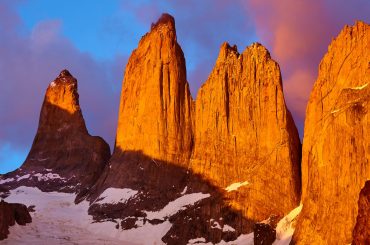
Getting from El Calafate to Torres del Paine
Write a comment cancel reply.
Save my name, email, and website in this browser for the next time I comment.
- Transfers & Getting Around
- Best time to visit
- How many days in Patagonia
- Exchange money
- El Calafate
- Puerto Madryn
- San Martin de los Andes
- Puerto Natales
- Punta Arenas
- Torres del Paine
- Bus & Car Transfers
Spark Nomad

The Best Time To Visit Patagonia: 4 Seasons & Activities To Try
Winter, spring, summer, or fall? If you’re wondering when to go on your dream vacation, read on, and you may just find the best time to visit Patagonia.
With Patagonia’s reputation as a paradise for outdoor adventure lovers preceding it, more and more travelers are making arrangements to go to this region, shared by Argentina and Chile.
The vastness and geographical diversity of this rugged, dramatic wilderness at South America’s southern tip may leave visitors confused about the most favorable time to visit.
This guide will help you learn more about Patagonia’s wonders in the context of its seasons and weather. Come well-informed and prepared to enjoy Patagonia at its best.
Table of Contents
When Is The Best Time To Go To Patagonia?
Patagonia is a popular travel destination, but many travelers are unsure about the best time to visit. To help with this decision, it’s important to understand Patagonia’s weather patterns.
Generally, the warmest and most comfortable months to visit are December through March. However, if you’re a fan of snow, you may prefer to visit starting in September. When planning your Patagonia itinerary , consider your preferences and choose a time that aligns with your ideal travel experience.
So it’s difficult to have one definite answer to this question. To clarify things, described below are activities done in different months; this will help you visit Patagonia during your desired time.
For Hiking, Whitewater Rafting and Penguin-Sighting
If you want to do hiking, whitewater rafting, and penguin-sighting, you should visit Patagonia from December to February. During these months, the weather in Patagonia is warm, with 17 or more hours of daylight. The long daylight duration means you can witness the beauty of Patagonian lands more.
Whitewater rafting is best done from November to March when snow meltwater from the Andes slopes begins to flow to the lakes. The rapids of Chile’s Futaleufu River and the Manso River near Bariloche in Argentina’s lake district are among the best sites for this thrilling sport.
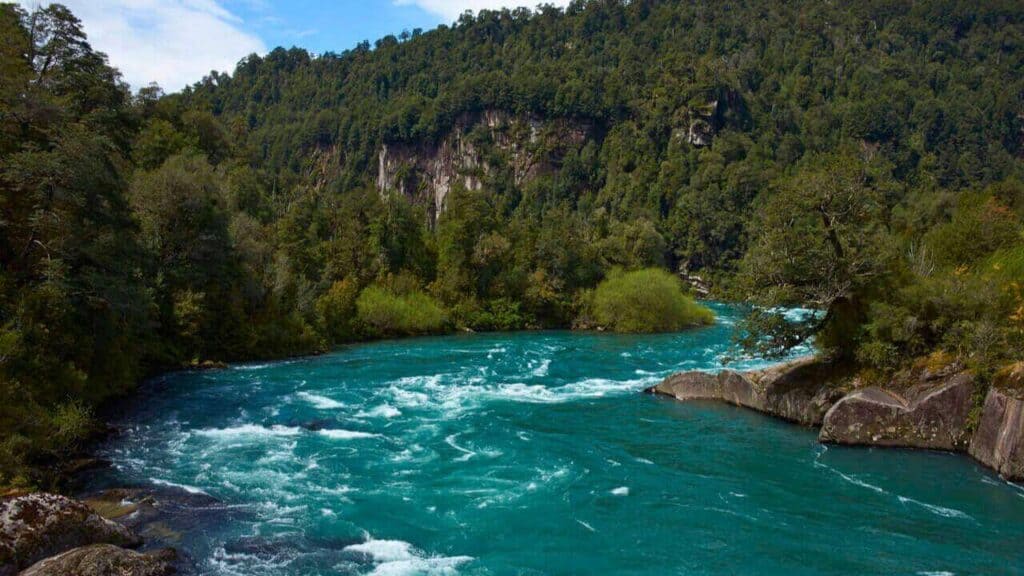
For Photography
Patagonia is so beautiful that it is a perfect spot for photographers. Mountains, glaciers, snow, and lakes surround the land, making Patagonia heaven on earth. If you want to capture Patagonia’s scenery, book your flight between March and April.
During these months, trees turn reddish-brown, adding to the land’s aesthetic scenery. Reddish-brown trees with mountains, lakes, and sunlight can give you award-worthy photographs.
For Winter Sports
Athletes who want to play in different parts of the world should prioritize playing in Patagonia. You can enjoy different sports during the summers; however, winter sports in Patagonia are famous and worth it.
Among the sports you can play during winters are hiking in Tierra del Fuego National Park, snowshoeing through the dense forests in Patagonia, skiing in one of Bariloche’s resorts, trekking on the famous Laguna Esmeralda, and discovering the southernmost city of the world- Ushuaia.
You can experience these activities if you get there between April and September. Along with these activities, you will have a chance to see snow-capped mountain peaks, which is an amazing sight.

Patagonia In Austral Summer
The majority of travelers visit Patagonia during summer from December to March. Travelers visit in summer because of the warm temperature and various activities. The moderate temperature allows you to enjoy Patagonia to its fullest because, in extreme winters, you can get too lazy to get out of your cozy blanket.
You can enjoy hiking, mountain biking, wildlife, and camping during summer. Hiking in the Fitz Roy , near the town of El Chalten, is on everyone’s bucket list because the region is considered the most beautiful place for hiking in Patagonia . El Chalten is also called the hiking capital of Argentina for a reason. There are plenty of hiking options from the city center, like the Laguna de los Tres and the Cerro Torres hikes.
It is an understatement to say that mountain bikes are worth riding in Patagonia, given its marvelous scenery – from the lava field of active volcanoes through the dense forest of Chile and northern Patagonia. Try one of the various bike tours that range from a 10-day bike tour through Patagonia’s Lakes District and the Island of Chiloé to a half-day Cross Fire Bike Adventure along El Calafate Mountain Park.
Hence, if you get a chance to fly to Patagonia during the summer, you should avail yourself of the opportunity.
Patagonia In Austral Fall
Patagonia during autumn is a beautiful sight to see. It is because the land is covered with reddish-brown leaves with orange/yellow trees. The lakes are also sprinkled with these leaves, which float at the water’s surface.
Along with the scenic beauty during fall, Patagonia experiences a low temperature which might not be pleasing to some travelers. Still, you should visit Patagonia between April and June to witness the mind-blowing, colorful scenery.
Hiking in the Torres del Paine National Park should be first on your bucket list because you can find clear skies at the national park, allowing you to see fantastic autumn colors.

During autumn, Patagonia is less crowded and more peaceful. So, if you are traveling with a family or a group of friends, it will be a great opportunity to visit and enjoy every place in peace.
However, since autumn and winter are considered off-season, it might be challenging to find accommodation because many hostels, camps, and hotels are closed. Be sure to check their availability in advance.
Patagonia In Austral Winters
Winters in Patagonia are severe. Several Patagonia tourist spots and accommodation facilities are closed because of the heavy snowfall, which is why Patagonia has the lowest crowds from July to September.
However, heavy snowfalls attract some travelers who want to enjoy the snow, so if you love snow and want to enjoy it the best way possible, you should visit Patagonia during winter. Patagonia has several activities for you in winter as well.
Try the chair lift ride to the El Calafate balcony as well as skiing, snowshoeing, snow biking, and tubing in Calafate Mountain Park . Besides, you can also enjoy skiing or snowboarding at several of the huge slopes that Bariloche offers. It’s the place to be if you enjoy the slopes.
You can have a chance to witness the wildlife on the shoreline of Valdes Peninsula , one of Patagonia’s marine reservoirs. From June onwards, huge colonies of elephant seals, sea lions, whales, dolphins, and penguins meet at Chubut’s coast to nurse and feed their young and to mate.

Patagonia In Austral Spring
Spring hits Patagonia from September to November. During these months, you can witness the bloom in Patagonia–new leaves and flowers make Patagonia so fresh and beautiful.
But spring is an off-season period in Patagonia because, at night, there are strong winds with a high possibility of rain. However, the off-season period has the advantage of bargain rates because the crowd is less. Owners of accommodation facilities open throughout the year are searching for customers, especially since they have to pay their hotel’s utility bills regardless of whether there are customers.
Personally, I visited Patagonia in October and November and loved it. The crowds were fewer, the hotel rooms had plenty of availability, and the temperatures were perfect. We luckily had little rain but were prepared with heavy rain gear and enough clothes to keep us warm.
How To Stay Safe During Your Visit In Patagonia
Traveling to Patagonia, offers an adventure through stunning landscapes of mountains, glaciers, and lakes. Given its remote and rugged terrain, safety is crucial. Here are essential safety tips for your Patagonia adventure:
- Layer Clothing: The weather in Patagonia can be unpredictable, with the possibility of experiencing all four seasons in one day. Wear layers that you can easily add or remove.
- Stay Hydrated : Always carry enough water with you, especially when hiking or engaging in outdoor activities.
- Proper Footwear : Wear sturdy hiking boots with good grip to navigate the often rocky and uneven terrain.
- Travel Insurance : Consider purchasing travel insurance that covers medical emergencies, evacuation, and trip cancellation.
Additionally, consider protecting yourself with travel insurance such as SafetyWing , which can cover medical emergencies, trip cancellations, and other unforeseen incidents during your stay. Use the widget below to snag the perfect policy for your needs and travel with peace of mind knowing you’ve got your back covered, no matter what adventures come your way!

Frequently Asked Questions (FAQs) – Best Time To Visit Patagonia
How many days do you need for patagonia.
Spending days in Patagonia depends on you. However, it is suggested that your trip should take at least 7 to 10 days. During this period, you can enjoy and experience most tourist attractions.
I recommend at least a month in the region if you have more time. You will have the time to explore the obvious sites like Torres del Paine (the W-Trek, for example), El Chalten, El Calafate, Ushuaia Bariloche, Pucon, and Puerto Varas.
What Is the Best Time of Year to Hike Patagonia?
Hiking attracts most of the tourists to Patagonia. The best time of the year to hike in Patagonia is summer, starting from December till February.
During summer, even with larger crowds, the weather is perfect for enjoying hiking to its fullest.
What Is the Warmest Month In Patagonia?
The warmest month in Patagonia is in late January when the temperature reaches 28° Celsius (82.4° Fahrenheit) during the day and around 15 degrees at night.
How Cold Is Patagonia In May?
May is the wettest and one of the coldest months of the year in Patagonia. The temperature drops to -6° C (21.2° F) and mountain peaks get covered in snow.
If you plan to come to Patagonia in May, you should pack your winter clothes.
Conclusion – Best Time To Visit Patagonia
So, what is the best time to visit Patagonia? Ultimately, there is no single definite answer to that question: it all depends on your travel preferences and objectives.
We hope this article provided insights into the advantages and disadvantages of the various Patagonian seasons. May you have safe travels and wonderful memories of your adventures in Patagonia!
Your Ultimate Travel Guide & Booking Resources
Skyscanner is my trusted ally for booking flights, guiding me to the perfect travel options while making the journey planning process a breeze with its user-friendly interface and extensive search capabilities.
12Go Asia is my ultimate travel companion in Asia, offering the best budget service platform for seamless booking of trains, buses, ferries, and flights, ensuring every adventure unfolds smoothly and effortlessly.
Booking.com is my ultimate lodging partner. It offers many accommodations worldwide and simplifies my travel experiences with its user-friendly platform and unbeatable deals.
Get Your Guide is my go-to for personalized travel experiences, enriching my journeys with unique tours and activities curated to my interests, making every adventure unforgettable and tailored to my preferences.
SafetyWing is my peace of mind on the go, offering comprehensive travel medical insurance with affordable plans and hassle-free claims, ensuring I can explore the world worry-free, knowing I’m protected wherever I roam.
LifeStraw Go Bottle is my trusted hydration companion for outdoor adventures, filtering water on-the-go to keep me safe and hydrated, ensuring every hike or travel experience is worry-free and enjoyable.
Related read:
- 15 Adventurous Things To Do On Your Patagonia Travel
- W Trek Patagonia – Things To Know Before Hiking Chile’s Popular Trek This Year
Founder of Spark Nomad, Radical FIRE, Copywriter
- Expertise: Personal finance and travel content. I’m a full-time traveler, and I’ve been to 49 countries and 5 continents.
- Education: Bachelor of Economics at Radboud University, Master in Finance at Radboud University, Minor in Economics at Chapman University.
- Over 200 articles, essays, and short stories published across the web.
Marjolein Dilven is a journalist and founder of Spark Nomad, a travel platform, and Radical FIRE, a personal finance platform. Marjolein has a finance and economics background with a master’s in Finance. She has quit her job to travel the world, documenting her travels on Spark Nomad to help people plan their travels. Marjolein Dilven has written for publications like MSN, Associated Press, CNBC, Town News syndicate, and more.

When is the Best Time to Visit Patagonia?
The best time to visit Patagonia is in the spring, summer, and fall, stretching from November through March. These months promise mild temperatures and long days of daylight. With its deep southern latitude, you might expect Patagonia’s weather to be more “polar” than it really is, but its austral summer temperatures are relatively moderate. Temperatures rarely drop below 40° and will usually reach into the high 60s and low 70s during the day. November (spring) is blessed with wildflowers and March (fall) beckons the start of spectacular foliage.

Keep in mind that the weather can change drastically, no matter the time of year. Enormous, unbroken stretches of ocean to the west and south of the tip of South America leave the Patagonian Andes exposed. Rain, sleet, and snow can occur at any time—perhaps just a few hours before or after sunny skies and 70° temperatures. Winds circling the globe between latitudes of 40°S and 60°S also have little obstruction, making spells of strong and persistent gusts (with speeds of, on average, 9-13 miles per hour) almost inevitable on any Patagonian journey. Prepare for this by wearing layered clothing and always having rain and/or wind protection handy.
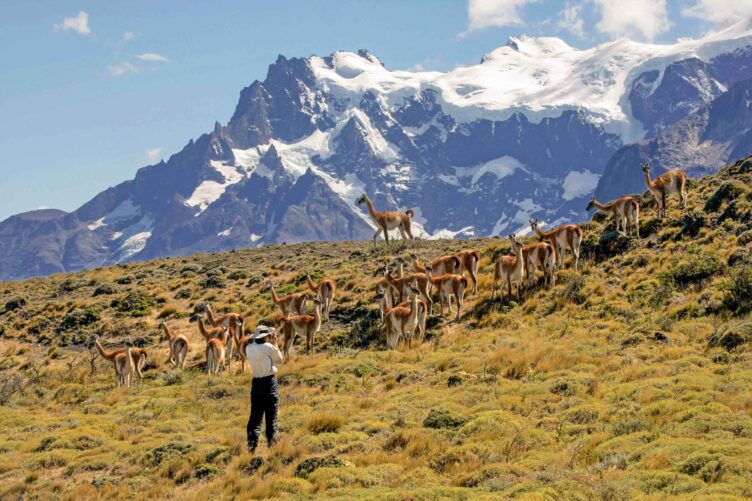
The start to spring has ideal shoulder-season conditions, with longer, warmer days that average temperatures in the high 50s, and relatively fewer people at the region’s most iconic sites. Plus, dazzling wildflowers are in bloom and baby animals are out and about. Join us on one of six group and private journeys, which kick off in spectacular fashion this month.
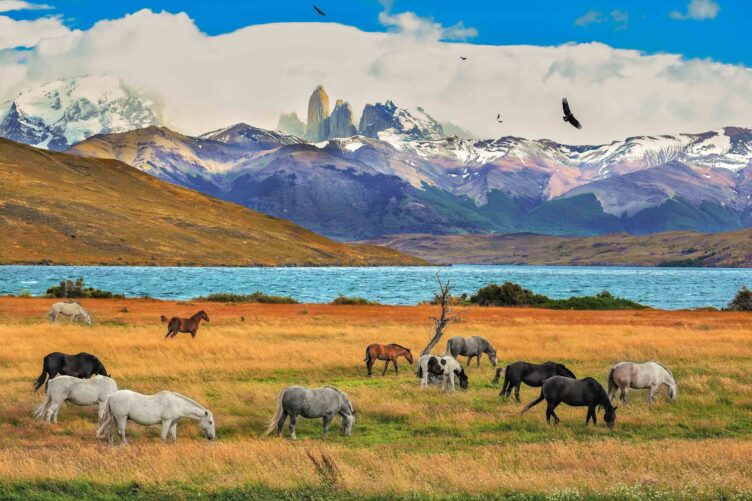
Clear skies, balmy temperatures, and lush landscapes that have recovered from the winter chill usher in the summer season, which is a great time to hike both Argentina’s Los Glaciares and Chile’s Torres del Paine, as well as spot chicks hatching in the penguin colonies along the fjords of Tierra del Fuego.
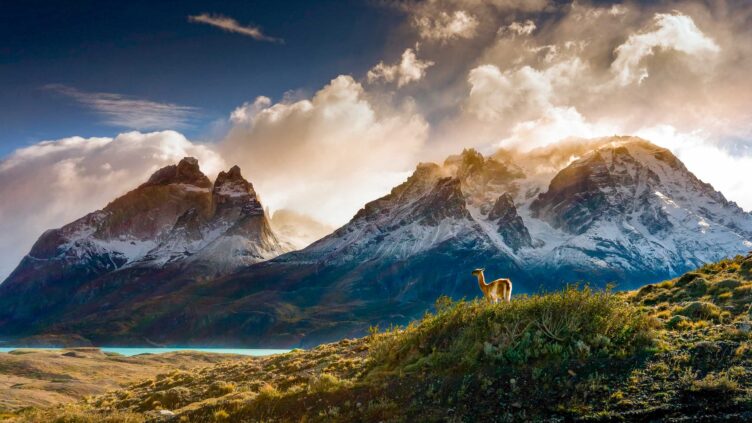
Patagonia enters the height of its summer, when warm temperatures and an average of 16 hours of daylight make for full days of exploration. Along with perfect hiking weather that averages the 60s during the day, this time of year is also when penguins begin nesting, one of many wildlife-spotting opportunities on WT’s expeditions.
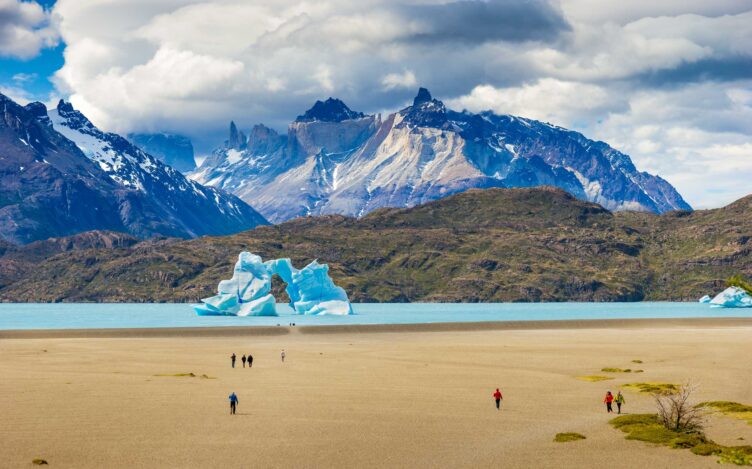
Similar to January, this month is an ideal time to experience all that Patagonia has to offer, from hiking in Los Glaciares and spotting pumas in Torres del Paine to cruising the fjords of Tierra del Fuego. The region’s fierce winds continue into late summer—expect average speeds of 9-13 miles per hour, which can occasionally gust much higher—so be sure to pack layers.

The start of autumn means landscapes shrouded in fall color, fewer crowds, and milder winds. If you prefer cooler hiking conditions, March is a great time to join a WT expedition, as daytime temperatures hover in the 50s and many of the region’s most popular sights will have quieted down.
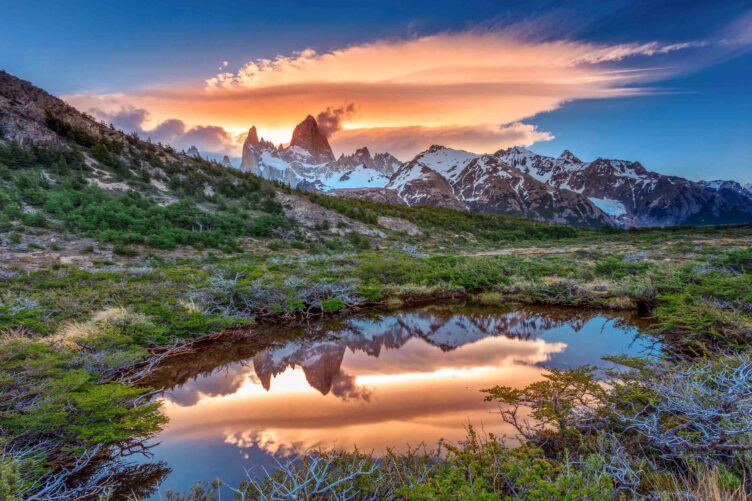
April to October
Short, cold days and heavy snowfall command Patagonia’s winter months, which are severe enough that most attractions, lodging, and restaurants will shut down at this time.
All Trips to Patagonia
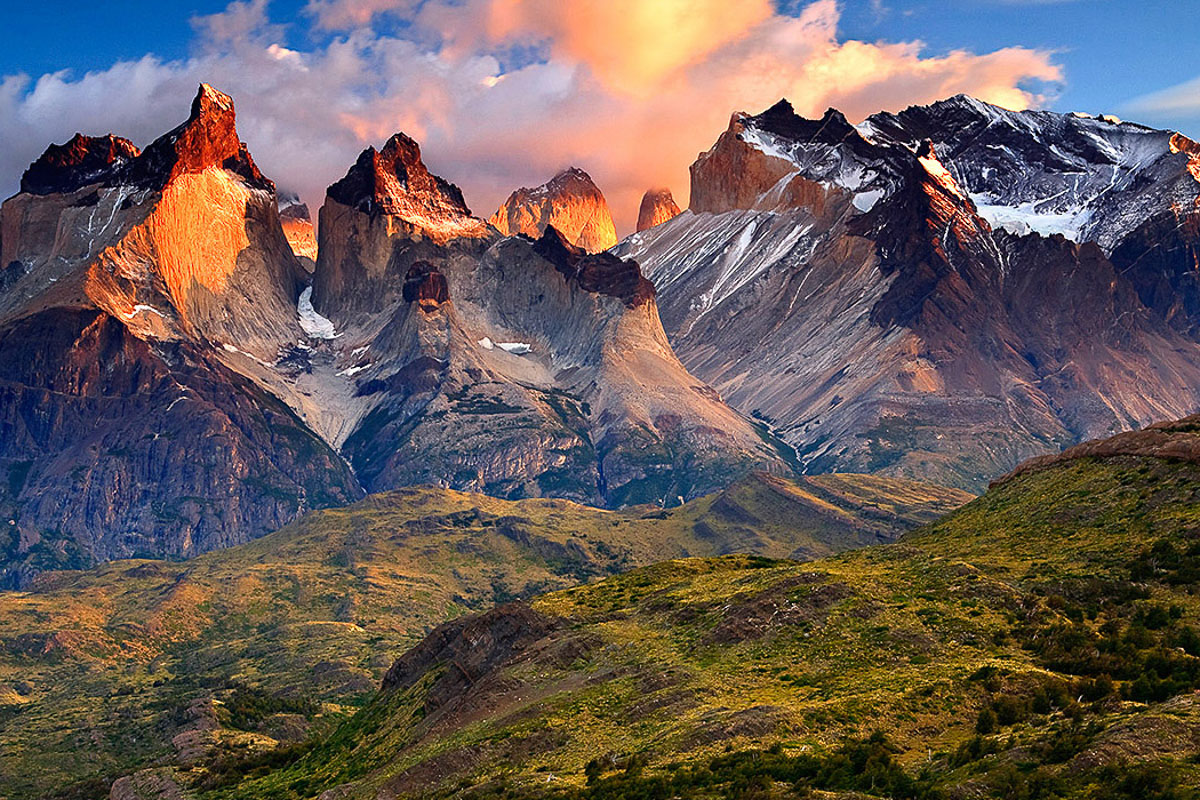
Small Group Adventure
Ultimate Patagonia
Argentina, Chile
From $10,995
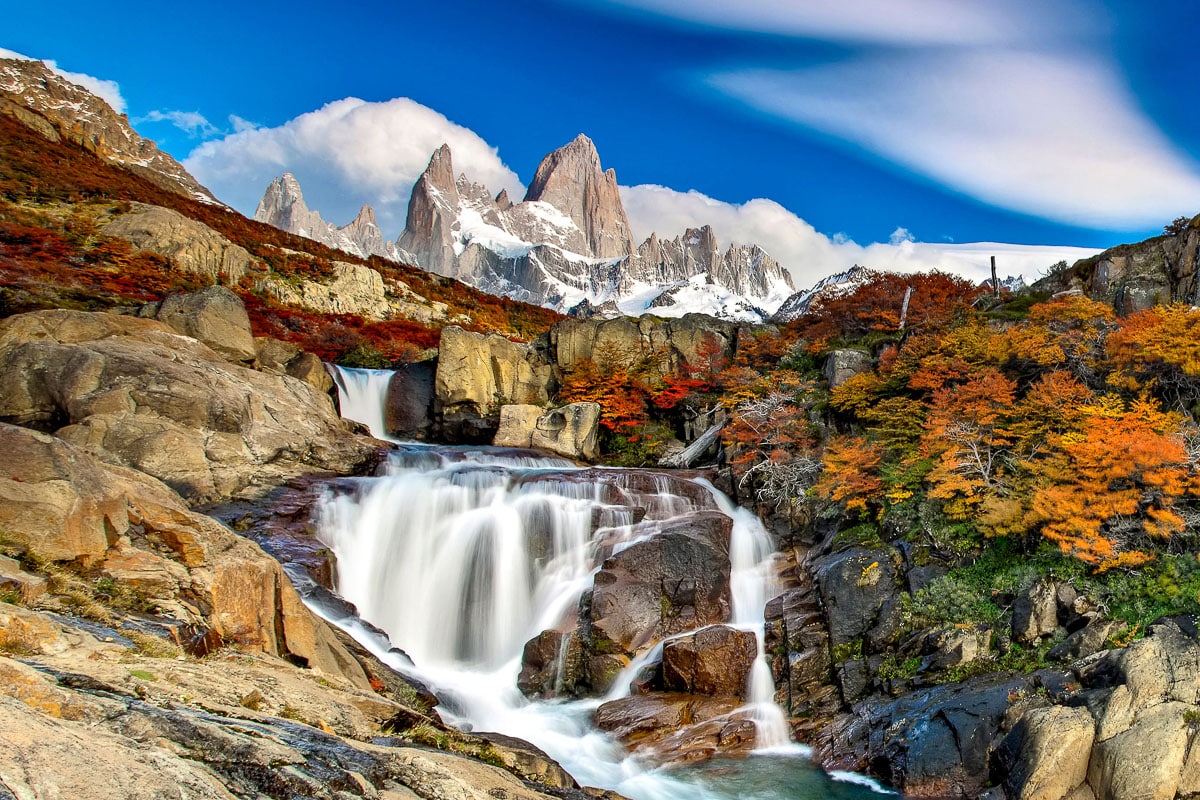
Argentina: Hikes and Estancias of Patagonia
From $7,995
Patagonia: Tracking Pumas and Cruising the Fjords
From $13,295
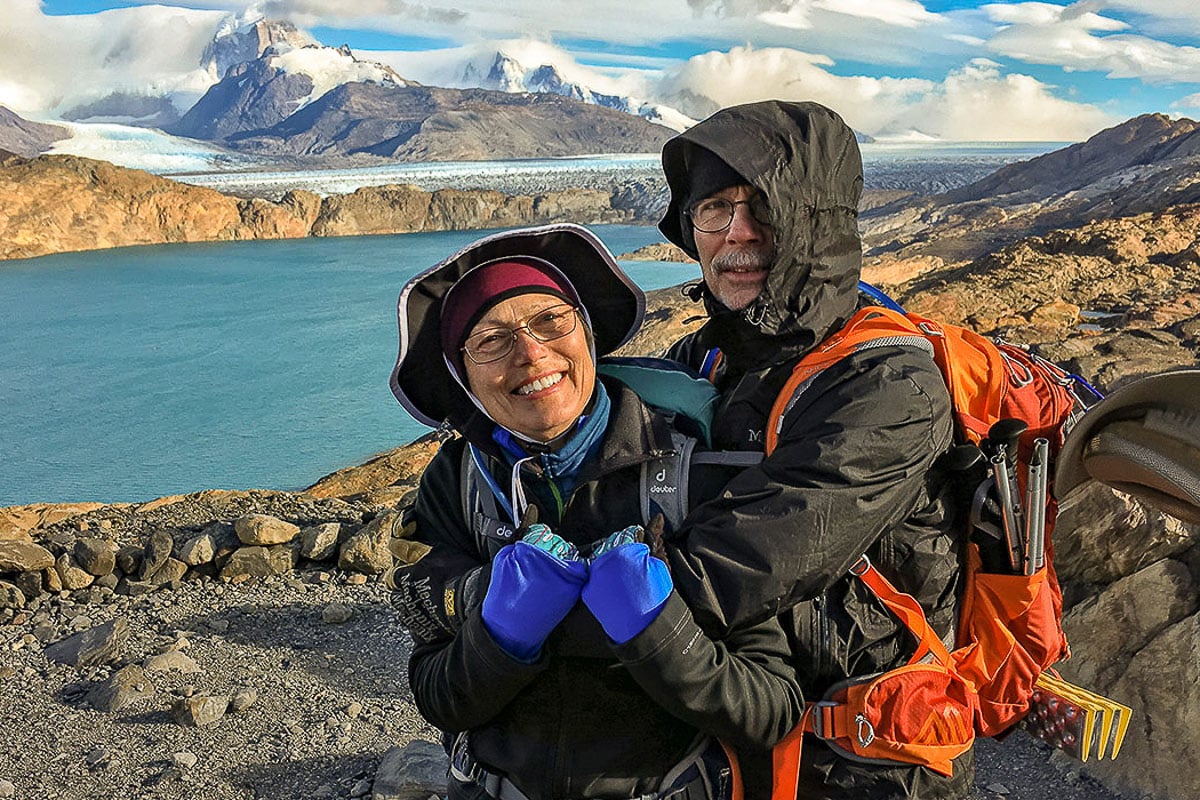
Private Journey
Argentina Private Journey
From $5,695
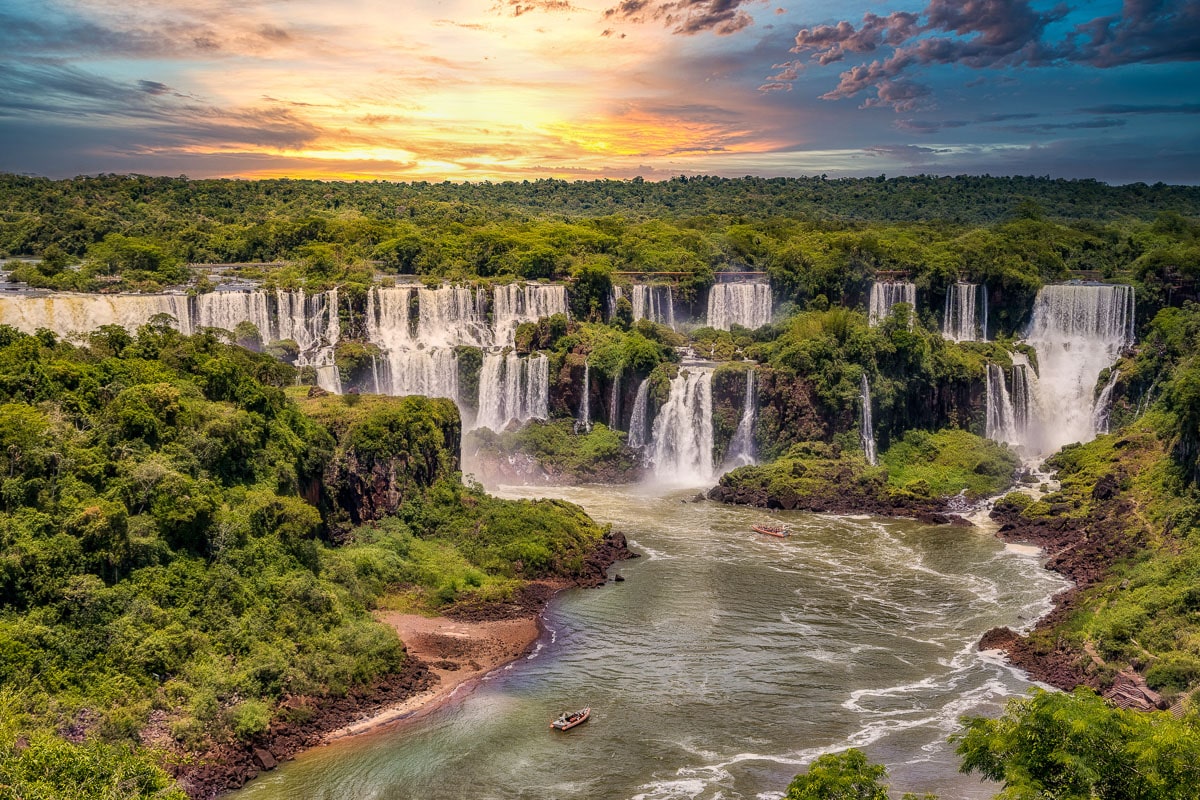
Argentina Family Private Journey
From $4,095
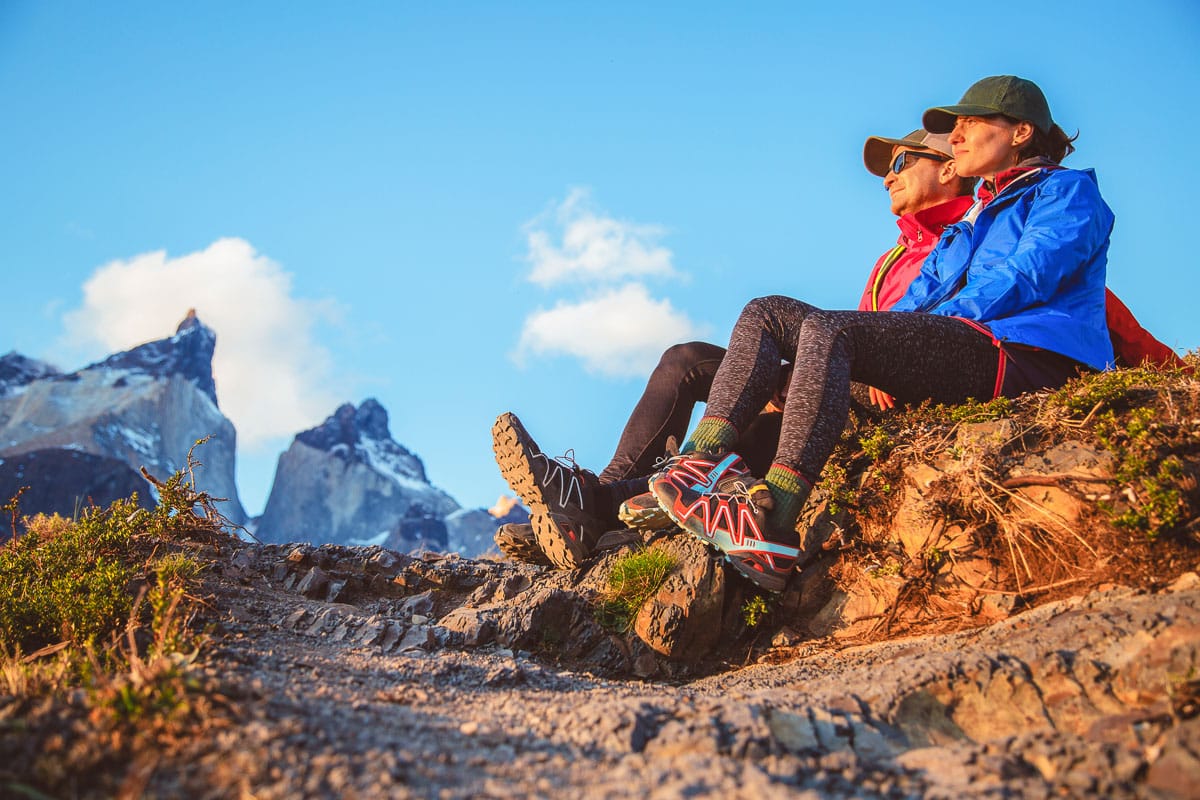
Chile Private Journey
From $5,995
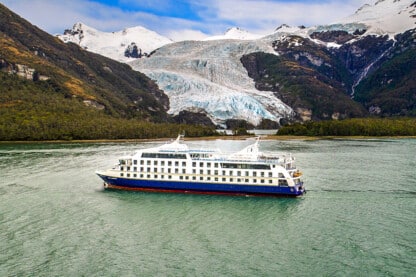
Cruise Collection
Darwin’s Route: Cruising through Patagonia
From $4,236
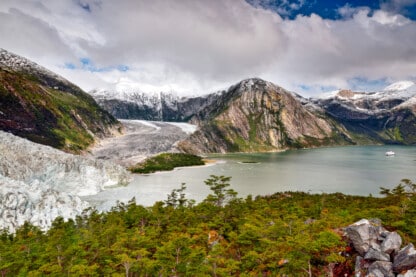
Tierra del Fuego Cruise, Punta Arenas to Ushuaia
From $1,665
Talk to an Expert
Our Latin America Specialists know every detail about our Patagonia trips. They will be happy to answer any questions and help you choose the journey that’s right for you. Contact us to learn more or book your trip today!
- Search Please fill out this field.
- Manage Your Subscription
- Give a Gift Subscription
- Sweepstakes
How to Travel to Patagonia
Here's everything you need to know about visiting Patagonia, including the best treks and places to stay.
:max_bytes(150000):strip_icc():format(webp)/Nora-Walsh-2000-1e93f87ed6fd4b669b3b1520510499a1.jpg)
Stretching across Chile and Argentina, Patagonia has long lured travelers to what is very nearly the end of the world. Here, in the countries' national parks, are snow-capped mountains, cobalt fjords, and old-growth forests. At the southernmost tip of the Americas, icebergs rupture with a dramatic roar from ancient, massive glaciers.
Torres del Paine National Park in Chile and Los Glaciares National Park in Argentina are two of the region’s top highlights, attracting hundreds of thousands of visitors per year. For a complete Patagonian travel journey, consider visiting both. Of course, doing so requires a lot of logistical planning — especially during the high season. Here’s a comprehensive guide to help you maximize your travels in this wonderfully remote corner of the planet.
Though most hotels in the region remain open year-round, you might find amenities and activities that keep tourists comfortable and entertained throughout the busy season are unavailable during winter in the Southern Hemisphere, which is from April to September.
To avoid the crowds and still experience good weather, visit during the spring when the flowers are in bloom, or fall when the leaves are a fiery mosaic of red, orange, and yellow. The summer months (December to February) have the mildest weather, but keep in mind that temperatures average below 70 degrees and winds are strong.
Travelers should be aware that the weather in Patagonia is highly unpredictable, particularly in spring and early summer. Weather and temperatures can fluctuate without warning, and violent storms can sweep in from the Pacific. It’s helpful to pad your schedule with additional days in case you encounter inclement weather.
How to Get to Patagonia
Because distances are quite long in Chile and Argentina, you will probably want to fly to Patagonia (unless you have several days to spare for a road trip from Buenos Aires or Santiago). Airline seats fill up quickly during peak season (December to February), so you should purchase tickets as far in advance as possible: Six months is ideal. For other months in the high season (October until early May), book at least three months ahead to avoid steep fares and limited options.
In Chile, LATAM Airlines serves southern Chilean Patagonia year-round with daily flights between Santiago and Punta Arenas, a common jumping-off point for Patagonia travel, with a flight time of three and a half hours.
Sky Airlines, Chile’s low-cost provider, also flies between Santiago and both Punta Arenas and Puerto Natales — another jumping-off point to Punta Arenas' south — often stopping at Puerto Montt, though passengers usually get to stay on the plane. Sky Airlines generally offers lower fares than LATAM.
Puerto Natales fares are cheaper the earlier you book. And as for driving time, it's three hours between Puerto Natales and Punta Arenas, two hours between Puerto Natales and Torres del Paine National Park, and four to five hours between Punta Arenas and the park.
In Argentina, Calafate and Ushuaia are the primary entryways, both less than a four-hour flight from Buenos Aires. These destinations are serviced by LATAM Airlines and Aerolineas Argentinas. Los Glaciares National Park, home to the famous Perito Moreno Glacier, is an hour's drive from El Calafate Airport. Another popular destination in this region is the trekking mecca El Chaltén, which is a three-hour drive from El Calafate Airport, where you can rent a car.
How to Get Around
Many of Patagonia's luxury hotels include transfers to and from the airport, as well as transportation for daily excursions. Traveling between Chile and Argentina can be done easily by land or sea. Unfortunately, there are no flights from Puerto Natales or Punta Arenas to El Calafate or Ushuaia.
By sea, Australis cruises run from the end of September to the beginning of April, connecting Punta Arenas and Ushuaia. Expeditions lasting four to eight nights navigate fjords, the Avenue of the Glaciers, the Strait of Magellan, Beagle Channel, and Cape Horn. Daily Zodiac rides get passengers up close to the ice and wildlife including penguin colonies and elephant seals.
For an overland trip, you can rent a car, organize a private transfer, or catch a bus. The bus company Bus-Sur connects Puerto Natales, Chile, and El Calafate, Argentina, daily during the tourist season and several times a week during the low season. The transfer takes five hours or longer, depending on how long it takes to clear customs. Book online at least a month in advance to guarantee a seat, especially during the high season.
Traveling by bus or organized tour is the most convenient way to cross the border because guides and drivers handle many of the logistics, but self-driving tourists travel between Chile and Argentina in private vehicles all the time. Do your research on the process before attempting a border crossing on your own.
What to Pack
In Patagonia, travelers will need to be ready for all kinds of weather. Since temperatures can go from freezing to 70 degrees over the course of a single day, it’s crucial that travelers pack layers. A waterproof jacket and trekking boots are essential, as are sunscreen and a pair of quality sunglasses (the sun can be extremely bright).
If you’re staying in upscale lodges, it's fine to bring a suitcase, but a backpack is needed for multiday trekking. Smaller backpacks are ideal for full- or half-day excursions. Many upscale hotels provide personal water bottles and trekking poles.
Packing Essentials
- Long thermal underwear that wicks perspiration
- Water-repellent hiking pants
- Light pullover or sweatshirt
- Fleece or down liner
- Waterproof parka or weatherproof jacket
- Hat for sun protection
- Liner or wind-stopper gloves
- Waterproof hiking boots
- Long hiking socks
- Neck gaiter
- Hiking backpack or day pack
Chilean Patagonia Travel Tips
Chile's portion of Patagonia is smaller and more rugged — i.e., less touristy — than Argentina's. Head to the Chile side to get off the beaten path and go beyond the major highlights.
Travelers flock to Patagonia to experience the otherworldly beauty of Torres del Paine National Park and spot Patagonia’s wildlife, including the Big Five: pumas, llama-like guanacos, South Andean deer known as huemul, Andean condors, and the ostrich-like rhea (or ñandú). There are also flamingos, foxes, penguins, and more than 100 species of birds. Several tour companies offer multiday puma-tracking safaris through the park.
Visitors will also want to explore the park’s old-growth forests. In the canopies of primeval southern beech trees (lenga, coihue, ñire) you can spot Magellanic woodpeckers and Austral parakeets.
Full- and half-day treks along the famous W Circuit (named for the shape of the route) offer one-of-a-kind vistas of sweeping freshwater lakes, teal lagoons, ice floes, and glimmering glaciers. The W Circuit is a roughly 50-mile trail that takes four or five days to walk and showcases major attractions. Trekkers settle into refugios (basic dorm-style shelters) or campsites for overnight stays.
Less remote, you can stroll through the colorful fishing town of Puerto Natales, or explore the region’s labyrinth of scenic fjords, where immense glaciers and marine life can be admired from the deck of a boat. On the shores of Punta Arenas, visit penguin colonies at Seno Otway or Magdalena Island and look out for sea lions and whales that populate the waters. You can also kayak the Strait of Magellan.
Where to Stay
Patagonia's luxury lodges offer all-inclusive packages that cover airport transfers, a wide range of full- and half-day excursions, and three gourmet meals per day with premium wine and cocktails. Explora is a pioneer in this category, offering dozens of expeditions led by experienced guides in Patagonia and Torres del Paine national parks. Besides that, 14 exclusive villas are the signature of Awasi , where guests have their own private guide and four-wheel drive vehicle to explore the scenery at their own pace.
Overlooking Lake Sarmiento and Paine Massif, Tierra Patagonia subscribes to an adventure spa philosophy. Guests are encouraged to unwind after jam-packed days of exploration with a massage or a session in the open-air hot tub.
For glampers, the sustainable EcoCamp is a geodesic dome hotel inside Torres del Paine National Park. Accommodations range from basic to over-the-top heated two-story tents that boast private terraces, bathrooms, and windows facing upward to the Patagonian sky. Assisted camping experiences on the trekking circuit are arranged by operators like Las Torres , Cascada Expediciones , MT Sobek , and Swoop Patagonia .
A number of upscale properties are located in and around the colorful fishing town of Puerto Natales, too. The Singular Patagonia , a property situated on the banks of the Last Hope Sound, is an early-20th-century national monument that’s been refurbished with industrial-chic accents.
At Lakutaia Lodge , on Navarino Island next to Cape Horn, guests are deeply immersed in the surrounding glaciers and fjords. But the real draw for adventurers is the opportunities to helifish and heliski.
What to Eat and Drink
Most of the lodges on private reserves offer full room and board, employing talented chefs who take advantage of locally sourced ingredients like white strawberries, rhubarb, seaweed, Patagonian honey, and gamier specialties like guanaco and Patagonian hare.
From the sea, try South American king crab, snook-and-hake ceviche, conger eel, choritos (mussels), and oysters. Wash it all down with a Chilean pisco sour or bottle of local wine.
Day Trips From Chile
Hotels in Chilean Patagonia offer a staggering array of full- and half-day excursions for just about any interest and fitness level: mountain trekking, horseback riding, cycling, kayaking, sailing scenic fjords, and glacier cruises, among others. For avid hikers, hiking to the base of Torres del Paine ("Mirador Las Torres") is a must-do. It’s a challenging, full-day out-and-back trip, but a clear view — weather depending — of the granite spires rising from the turquoise glacial lake is an ample reward.
You can take a Zodiac voyage to get up-close views of ancient, glistening glaciers. Grey Glacier is a popular destination, as are the Balmaceda and Serrano Glaciers, accessible from the wharf in Puerto Natales. Otherwise, spend the day with Chilean cowboys at the family-run Estancia Mercedes for horseback riding along fjords.
General Tips for Visiting Chile
- When visiting during Chile’s summer months, beware of biting midges. Spray yourself with natural insect repellent at regular intervals and wear light-colored clothing with long sleeves, as these small flies are attracted to dark colors.
- If you are an avid hiker, avoid heavy crowds of backpackers in Torres del Paine National Park by traveling in November or April.
- On challenging treks, opt for two trekking poles. They will save your knees on the descent.
Argentine Patagonia Travel Tips
Argentina's portion of Patagonia is larger and more geographically diverse than Chile's portion. Another potential benefit is that the Andes Mountains leaves Argentina in a rain shadow, meaning it stays dry while the Chilean side takes the rain that rolls in from the Pacific.
The 97-square-mile Perito Moreno Glacier — a declared UNESCO World Heritage site in Los Glaciares National Park — attracts tens of thousands of visitors every year. Located near El Calafate in one of the world’s most exceptional ice fields, it’s a must-see on the Argentine side of Patagonia. Boat cruises on Argentina's largest freshwater lake, Lake Argentino, will take you close enough to witness colossal icebergs fall from the glacier into the water. Some tours give visitors a chance to hike out onto the glacier wearing metal crampons.
Visiting the area’s historic estancias offers travelers a glimpse into the rural life of Patagonian ranchers. Estancia Cristina and Nibepo Aike (see below, Where to Stay) are destinations in their own right. Unspoiled landscapes and opportunities to hike, horseback ride, and visit the area’s stunning glaciers are abundant.
Three hours north by car from El Calafate is the laid-back hiking hamlet of El Chaltén, famous for its towering Fitz Roy mountain peak. The tiny frontier town is dotted with picturesque chalets and a network of scenic trails that suit every skill level.
You’ll travel to the “end of the world” in Tierra del Fuego. Its capital city, Ushuaia, is a port of arrival or departure when traveling by sea between Argentina and Chile. Take a boat cruise or catamaran trip to see penguins, sea lions, and cormorants inhabiting the legendary Beagle Channel made famous by naturalist Charles Darwin on his Beagle voyage in 1831.
Tierra del Fuego National Park offers a lush sub-Antarctic rain forest shaded with beech trees, while Glacier Martial offers a panoramic view of Ushuaia and the channel. International anglers make pilgrimages to the banks of the Rio Grande in the hope of hooking a record-breaking brown trout.
Two pleasant hotels offering relatively affordable accommodations right on the southern shore of Lake Argentino are Esplendor El Calafate Hotel and Xelena .
EOLO , 30 minutes west of El Calafate, is built on 10,000 acres of arid steppe and pampas grass with lake views. Antiques, heavy wooden furniture, and mismatched dishware give the lodge a cozy country atmosphere. Nearby, guests can take guided treks, go horseback riding, mountain biking, and bird-watching. The hotel can also arrange excursions to the Perito Moreno and Upsala Glaciers. Book one of the corner suites for an especially good view.
Further out of town is Estancia Cristina , an early-20th-century sheep ranch accessible only by the resort's boat across Lake Argentino. Set on 54,000 acres of wild Patagonian terra firma, the preserved estancia offers a menu of excursions including trekking, horseback riding, and sailing among icebergs near the Upsala Glacier.
Meanwhile, Estancia Nibepo Aike on the shore of Lake Roca is a working ranch founded by a Croatian pioneer at the turn of the 20th century. The estancia still raises cattle and sheep, granting guests the opportunity to see sheep be sheared, learn cowboy skills on horseback, and sample a traditional prepared asado (barbecue) of Patagonian lamb. Guests can also take day trips from here to explore the lesser-visited glaciers Cubo, Frías, and Dickson.
Between El Chaltén and El Calafate, you can stay at Helsingfors Lodge , a former ranch set on the shores of Lake Viedma with great food and stunning mountain views. On Lake San Martin, several hours north of El Calafate, there's also the pristine private nature reserve that houses Estancia El Cóndor , named for the nearby condor nesting sites.
Los Cerros , located on a hilltop providing epic views of El Chaltén, is the most luxe option in a backpacking haven brimming with hostels. And the exclusive Aguas Arribas Lodge , about an hour's drive north of El Chaltén, is a secluded lakeside retreat looking upon the north face of Mount Fitz Roy.
In Ushuaia, luxury properties Los Cauquenes and Arakur Ushuaia Resort & Spa both overlook the Beagle Channel and offer guided wilderness hikes and excursions on the water.
Most estancias offer full board with three meals per day, but there are some local delicacies you must check off your list.
El Calafate gets its name from the calafate berry (barberry), and there is a local legend that says whoever eats one will return to Patagonia. Try calafate gelato, calafate liqueur, and delicious jams made from chaura (prickly heath) and zarzaparrilla (wild currant).
Experiencing a Patagonian asado is a must at one of the estancias . Watch the asadors cook local lamb on an iron cross over a live fire and enjoy it with a glass of Patagonian pinot noir in hand. One of the best restaurants for grilled cuisine is La Tablita in El Calafate. In Ushuaia, dine on classic Argentine seafood at the restaurant Kaupé , considered one of the best in the country.
While you're in Argentina, be sure to try Beagle , a beer brewed using meltwater from nearby glaciers. However, arguably the most important and culturally significant of all Argentine drinks is mate. It's a longstanding social ritual to drink yerba mate tea, a caffeine-rich blend of dried herbs steeped in hot water, from a hollowed gourd or wooden mate cup. Of course, you must use a bombilla (a traditional straw) for the full experience. Try adding a little sugar if the taste is too bitter for your palate.
Day Trips From Argentina
UIG/Getty Images
A trip to Perito Moreno Glacier in Los Glaciares National Park is one of Patagonia’s most iconic excursions. Book an ice trekking adventure — big or small — with Hielo & Aventura .
Another guide company, Marpatag , takes guests on multiday glacier adventure sailings along Lake Argentino, visiting the Upsala, Spegazzini, and Perito Moreno Glaciers.
A full-day excursion to Estancia Cristina includes a boat ride past glaciers and waterfalls, too. Cañadon de los Fosiles is a 4.5-hour trek from the estancia providing views of Lake Guillermo and the Upsala Glacier before descending through a valley of ancient fossils.
El Chaltén offers a variety of scenic day hikes including the Cerro Torre Trek, which takes about six hours, and the more challenging Mount Fitz Roy Trek, an eight-hour hike to Laguna de los Tres. You can also ice hike atop the Viedma Glacier.
In Tierra del Fuego, look for marine wildlife in the Beagle Channel or visit panoramic lookout points on hikes through Tierra del Fuego National Park.
General Tips for Visiting Argentina
- Perito Moreno Glacier’s ice treks have strict age limits — typically from 18 to 65 years old — that differ by tour.
- If you plan to spend a night at Estancia Cristina, you should overnight in Calafate before and after, as the boat departs early in the morning and returns in the late afternoon.
- Avid hikers should visit El Chaltén in November or April to avoid heavy crowds.
- Outdoor equipment is expensive in Argentina, so be certain you’re well equipped before traveling.
Do Americans Need a Visa to Visit Patagonia?
The capital cities Santiago, Chile, and Buenos Aires, Argentina, both serve as gateways to Patagonia. Americans do not need a visa or to pay a reciprocity fee to enter either country.
Which side to start on is a matter of personal preference. However, if you plan to visit both countries, you can start in one city and finish in the other, so you have the opportunity to experience both.
- Visit Oyster on Facebook!
- Visit Oyster on Pinterest!
- Visit Oyster on Instagram!
- Visit Oyster on Twitter!
- Subscribe to stay up to date!
Yes, send me expert tips and deals!
By proceeding, you agree to our Privacy Policy and Terms of Use .
- Subtract one room 1 Rooms Add one room
- Subtract one adult 2 Adults Add one adult
The Best Time to Visit Patagonia
See recent posts by Neil Gladstone
Travelers who venture to Patagonia have to be more mindful of seasonal changes than most visitors to South America . The region encompasses about one-quarter Chile and three-quarters Argentina, and is home to everything from barren plains to coastal regions to some of the world’s tallest mountains. In the winter (June and July), the average temperature drops down to 32 degrees Fahrenheit and many of the rugged mountain passes that typically draw hikers are covered in snow. In the summer (December to February), temps rise as high as 72 degrees, but the crowds are also at their largest and skiers won’t find the Andean slopes at their peak. The best time of year to visit Patagonia vary depending on what you want to see and do. Here are the optimal things to check out based on the season you choose to visit in.
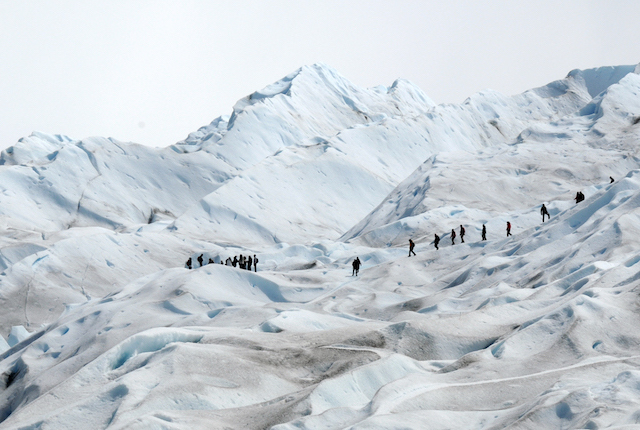
Kerry O’Connor/Flickr
At the height of winter, visitors will only get about eight hours of sunlight. However, those who appreciate the feeling of braving a wild frontier should consider a visit during this season, which extends from July to September. Torres del Paine National Park, in the southern tip of Chile, is a big attraction all year round. During the winter, the winds die down, the skies clear up, and the mountains and glaciers are primed for panoramic pictures. Granted, the weather can be temperamental, as it is all year, and the park’s services are limited, but on the right day, a hike on Glacier Grey or through Pingo Valley will feel like a heroic coup. Argentina’s Los Glaciares National Park boasts the largest ice cap outside of Greenland and Antarctica.
To get a break from the cold, stop by the El Calafate Historical Interpretation Center, which is filled with towering dinosaur fossils and stories of indigenous civilizations that lived in the area when Magellan arrived in 1520. On the east coast of Argentina, Puerto Madryn offers excellent views of the southern right whales that swim to the area to breed from June to December. In the winter, they get so close to the coast of Golfo Nuevo and Golfo San Jose that going out on a sightseeing boat isn’t necessary.
Hardcore skiers have several options for world-class slopes with views of granite peaks and glaciers. Argentina’s Cerro Catedral is a great mountain option for snowboarders and freestyle skiers (One of its most impressive runs is five miles long.) While Cerro Catedral is arguably Argentine Patagonia’s most popular ski destination, La Hoya’s remote location in the northwest of the Chubut Province offers less crowded slopes and plenty of runs for expert and intermediate shredders. If you’re considering renting a car during this season, keep in mind that most of the highways are passable, but some areas on the Chilean part of the Tierra del Fuego islands are notoriously difficult for driving. It’s wise to check conditions for any major road trip.
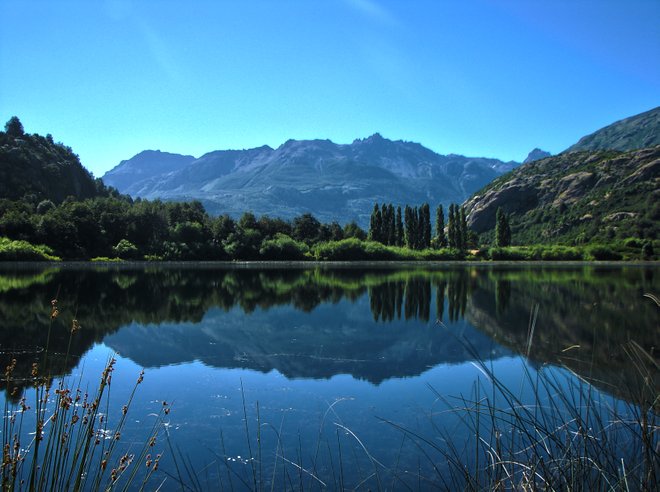
Juan Manuel/Flickr
Depending on the month, spring in Patagonia can bring 12 to 17 daylight hours. Many consider this season, which extends from September to December, to be the best time to visit the region. The ice and snow dissipate, making mountain trails passable again. Yes, there will still be a little chill in the air, particularly at night. Temperatures can range from 57 degrees in the day down to 36 degrees at night. Plus, popular spots like Cerro Fitz Roy, which lies on the Argentinian/Chilean border, become less crowded, particularly in early spring. The lack of visitors also makes it easier to spot hard-to-find animals, such as the huemul deer in places like Bernardo O’Higgins National Park, Chile’s largest reserve.
For skiers, springtime provides enough powder on the slopes to get in some primo runs. Adventurers who thrive on a combination of fire and ice can head to Nevados de Chillan, which has piste trails surrounded by three volcanoes. The curves of the trails are shaped by the area’s lava flow, and the plentiful snowfall averages 400 inches annually.
In September, Chileans celebrate their independence during Fiestas Patrias, which can last from two days to a week in some parts of the country. Party vittles include plenty of barbecue and empanadas packed with beef, hardboiled egg, and olives. Wash it all back with chicha, a sweet wine made from grapes or apples. Springtime in Patagonia is also easier on the wallet; hotels, flights, and tours all have lower price tags.
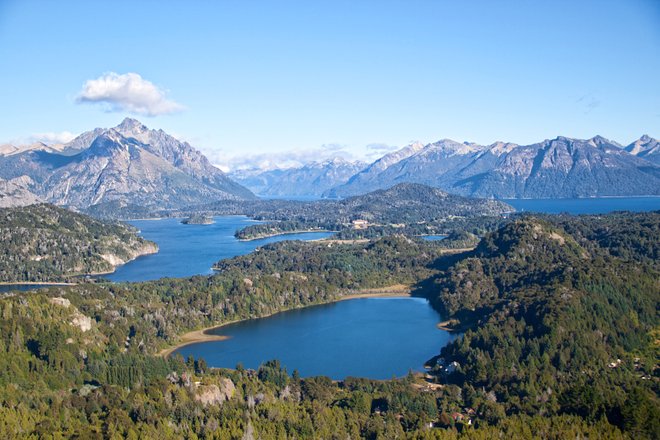
Cathy Arkle/Flickr
There’s a reason why summer is the season that brings crowds to Patagonia. The balmy temperatures range from 71 degrees in the day to 41 degrees at night. Similar to spring, the daylight lasts from 13 to 16 hours, changing slightly from the month to month. Yes, this is the high season, but keep in mind that Patagonia is over 400,000 square miles, so it won’t exactly feel like you’re waiting in a long line at Disneyland. Some of the wildlife that’s more active in the warmer months might be scared away by the large crowds, so travelers interested in seeing a puma may want to consider visiting in the spring or fall. For lovers of flora, flowers and forests are bursting during this time.
Many climbers make El Chalten in Argentina’s Santa Cruz province the starting point for hikes in Los Glaciares National Park and the Cerro Torre mountain. A laid-back atmosphere permeates the town, and plenty of accommodations for camping are available. On the east coast, Puerto Madryn is a major hub for scuba diving. Much farther south in Puerto Natales, kayakers can explore the majestic fjords that bewildered early European explorers. The first few months of the year are also the best for sailing through the Strait of Magellan and catching a close-up view of penguins on Magdalena Island.
The Semanas Musicales de Frutillar, which takes places in February, is one of the biggest music events in Chile, with concerts featuring classical music, chamber music, and big band. Not surprisingly, travel and accommodation prices are at their highest during this time of year.
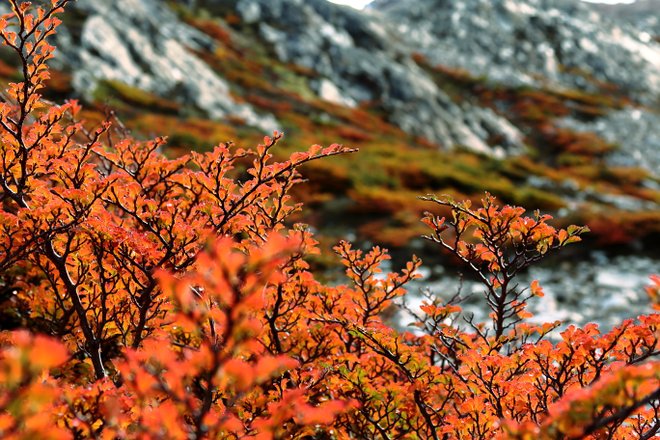
strudelt/Flickr
Vacationers who want to witness Patagonia’s vibrant display of yellow, red, and orange should visit in the fall. Temperatures get colder from March to June (the average ranges between 64 and 36 degrees Fahrenheit). Daylight dwindles from about 11 hours in March to eight hours in June. Hiking in Torres del Paine National Park is particularly popular in the fall, thanks to its panoramic views of grasslands, glaciers, and mountains. You might even spot animals like guanacos (relatives of camels).
Autumn is also an excellent time for driving through the Road of the Seven Lakes. The 150-mile round-trip route usually begins in Bariloche or San Martin de los Andes. In addition to lakes, the day-long ride winds past forests and a waterfall. Those who start from Bariloche will want take in the town’s alpine-style architecture, much of which was built in the early 20th century to make the destination resemble a European ski village. Some refer to it as “Little Switzerland,” and like the European ski getaway, Bariloche has plenty of top-notch chocolate shops.
As for events in Chile, on the first Sunday after Easter, riders on horseback gather to bring communion to the sick. The horsemen wear elaborate costumes and escort the priest in the parade.
You’ll Also Like:
- Your Guide to Patagonia: 8 Places You Can’t Miss
- Argentine vs. Chilean Patagonia: Which One Is Right for You?
- Where to Go in South America: A Cheat Sheet to the Continent’s Countries and Territories
All products are independently selected by our writers and editors. If you buy something through our links, Oyster may earn an affiliate commission.
Top Stories

- Travel Tips
Top 11 Las Vegas Hotels on the Strip for Every Type of Traveler
By Christina Vercelletto

7 Amazing Mother-Daughter Trips to Take This Year
By Megan Johnson
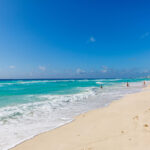
- Cabo San Lucas
Cancún vs. Cabo: Which Mexico Travel Destination Is Better for You?
By Lilly LeClair

- Adults-Only
Hyatt Launches Adults-Only Brand, Hyatt Vivid
- Best Time of Year to Visit Patagonia

Want to Go?
Patagonia travel guide.
- All Patagonia Trips
- Punta Arenas
- Torres del Paine
- Luxury Patagonia Cruises & Tours
- Patagonia- The Last Refuge of Nature
- Trekking & Hiking in Patagonia
- Patagonia Lodges
- History and Geography of Patagonia
- Patagonia FAQs
- Perito Moreno Glacier
- Tierra del Fuego Culture
- Patagonia Lowdown: Low Elevation South America Treks
Favorite Patagonia All Trips
- Classic W Trek
- Patagonia Hiking Express
- Highlights of Southern Argentina
- Fitz Roy & Glaciers Trekking
- Tierra del Fuego Explorer
- Ultimate Patagonia Trekking
Top Patagonia Travel Destinations
- Ainsworth Bay
- El Calafate
- Magdalena Island
- Puerto Natales
- Tierra del Fuego National Park
Patagonia Trips by Departure Date
- 2024 Patagonia trips (87)
- 2025 Patagonia trips (83)
- 2026 Patagonia trips (56)
- April 2024 (57)
- October 2024 (61)
- November 2024 (66)
- December 2024 (70)
- January 2025 (68)
- February 2025 (65)
- March 2025 (70)
- November 2025 (53)
- March 2026 (53)
Top Experiences in Patagonia
- Patagonia Land Tours (44)
- Patagonia Cruises (35)
- Patagonia Active (24)
- Patagonia Wildlife & Safari Exploration (23)
- Patagonia Trekking (17)
- Patagonia Luxury (9)
- Patagonia Family (8)
- Patagonia Most Popular (7)
- Patagonia Cultural (6)
- Patagonia Solo Travel (6)
Patagonia Trips by Duration
- 5 day trips (20)
- 6 day trips (10)
- 7 day trips (9)
- 8 day trips (8)
- 9 day trips (10)
- 12 day trips (4)
- 13 day trips (6)
- 15 day trips (4)
Patagonia Trips by Activity
- Patagonia wildlife viewing (57)
- Patagonia hiking (46)
- Patagonia small ship cruises (30)
- Patagonia kayaking (21)
- Patagonia horseback riding (18)
- Patagonia camping (15)
- Patagonia whale watching (15)
- Patagonia adventure options (12)
- Patagonia wilderness lodge exploration (8)
- Patagonia village visits (7)
- Patagonia wine tasting (7)
- Patagonia whitewater rafting (7)
- Patagonia fishing (6)
- Patagonia spa relaxation (6)
- Patagonia biking (5)
- Patagonia land & sea exploration (3)
- Patagonia local market visits (3)
- Patagonia fly cruises (3)
- Patagonia skiing (3)
- Patagonia urban exploration (3)
Why Travel With Adventure Life
Recognized by.

The Best Time to Visit Patagonia
Notorious for its four-seasons-in-a-day weather, Patagonia is a region where the answer to “when is the best time to visit?” goes beyond simply identifying the warmest months. Patagonia is vast, touching both the Atlantic and Pacific coasts and spanning fjords, desert steppe, temperate rainforest, and the Andes mountains (and their fickle high-altitude climate.) With weather that’s apt to change quickly, microclimates, winds, and 14 degrees of latitude, there is no single best time to visit Patagonia. Instead, we can consider the upsides of traveling during each season—which may have nothing to do with the weather.
When is the best time to visit Patagonia?
Unless you’re traveling for winter sports, Extraordinary Journeys South America specialists recommend visiting Patagonia in spring, summer, and fall. Summer (December, January, and February) is predictably the warmest time of year, but it’s also when Patagonia’s hair-whipping winds can be at their fiercest, and some destinations can be busy with visitors. Spring and fall are slightly cooler but pleasant, winds tend to be less extreme, and crowds thin.
Where to travel in Patagonia: Month by month
Generally, anywhere in Patagonia will be pleasant from October through April, but for some travelers, the best time to visit Patagonia might have nothing to do with the weather. Depending on your ambitions, the ideal month could mean shirking crowds on popular national park hiking trails, timing your trip around a whale migration, aligning with the departure of a luxury small ship cruise to Antarctica , heli-skiing the southern hemisphere winter, or a desire to catch spring wildflowers at the height of their splendor. In this guide, we highlight destinations that shine in each month.
Visiting Patagonia in January
Weather-wise, January is a fantastic time to visit Patagonia. To get away from the crowds, explore the rugged landscape of the Chiloé Archipelago near Puerto Montt . (We love to base clients at Tierra Chiloe .) With average temperatures of around 63°F, it’s still warm enough to layer up and kayak, go horseback riding, and visit the island’s iconic wooden churches built by Jesuit missionaries in the 17th and 18th centuries. A day trip to Chiloe National Park, where you can walk the gentle trails of the Valdivian temperate rainforest and admire views of Cucao Lake, is a must-do. Along this coastal forested route, you’ll likely spy the sea lions that congregate here, and keep an eye out for blue whales, too.
Visiting Patagonia in February
February is “late season” for voyages to Antarctica, and many ships have already left, with the majority sailing in December and January. But don’t overlook February as an option! Days gradually shorten, and you can sleep comfortably without the midnight sun streaming in. And bonus: sunsets are fabulously long. Whales are out and about, and humpbacks peak in numbers. Penguin chicks start to molt and parents scramble to try to get as much food into them before winter hits. Returning back to Ushuaia , you’re greeted with fall weather and the kaleidoscope of colors that come with it.
Laced by lakes and rivers, Patagonia has a reputation for world-class fly fishing. February is firmly trout season, which spans November to March. Estancia Cristina will satisfy anglers fixing for catch-and-release salmon fishing at the headwaters of Río Caterina. When you’re not fishing, enjoy superb hiking and gaucho-guided horseback riding in an area where the Patagonian end-of-the-world vibe is palpable.
Visiting Patagonia in March
In March, the leaves are changing from green to blazing yellow, orange, and red. The bold contrast against milky opaque lagoons and blue glaciers is visually arresting. Appreciate the crunchy-crisp autumn aura while cruising Chile’s fjord-pocked coast. (Hello, penguin colonies and migrating whales!) Otherwise, take to the open road. We love the scenic route connecting San Martin de los Andes with Bariloche and onward to Esquel in Argentina’s Lake District. Or, journey a little further south, along Chile’s Carrera Austral.
Visiting Patagonia in April
Torres del Paine National Park is jaw-droppingly gorgeous any time of the year, but the summer months can be overwhelming with the volume of hikers. (And in winter, many snow-packed trails close.) The shoulder season of April means lenga trees turn a vivid orangish-red, contrasting with the turquoise water of the glacial lakes—a dazzling visual. Also, if you’ve got your heart set on spotting one of Torres del Paine’s elusive pumas, a quieter month like April means the predators are more likely to be more widely roaming the area.
Visiting Patagonia in May
May is an ideal time to visit Futangue Park , a nature reserve of Valdivian rainforest at the foot of the Andes in the Los Ríos region of Chile’s Lake District . It has one of the largest lakes in the country, Lake Ranco , and borders Puyehue National Park with its famous volcanoes and lava fields. If the weather is pleasant, you can mountain bike, hike, or go bird watching. And if it ends up being too crisp for your liking, a day trip can be made further north to the region of Pucon to soak in some of Chile’s best hot springs.
Visiting Patagonia in June
June might not be the best month to visit Patagonia, but it’s definitely doable.
It’s a transition period when the fall leaves have dropped but winter hasn’t officially set in. It can be cold, windy, and rainy in any part of Patagonia, so you may as well roll with the punches and cozy into a luxury lodge with postcard-perfect views, a hot tub, sauna, an extensive Malbec list, and delicious Patagonian comfort food. Las Balsas comes to mind, as there may be a bit of snow to provide a picturesque ambiance, but the ski bunnies that flock to Cerro Bayo ski center usually haven’t made their way here until July.
Visiting Patagonia in July
Heading to Bariloche in July means the slopes are open, but the volume of snow travelers haven’t arrived yet. Head to Cerro Catedral , one of the continent’s largest ski resorts, for fresh powder without too many tourists and to enjoy après-ski at one of Bariloche’s many craft breweries. The alpine town is also known for high-quality handmade chocolate, so it’s a win-win all around. If you prefer flat ground, you can always try snowshoeing your way through trails around Bariloche.
Visiting Patagonia in August
If you know going in that it’s going to be cold, dry, and wintry, you may as well embrace it and head to El Calafate for some glacier time at Perito Moreno Glacier . Many national parks in Patagonia close over the winter, but Los Glaciares is not one of them. The park is usually crowded the rest of the year but in August, you might have the boardwalks (practically) to yourself. Cozy into a luxury lodge like Eolo that has a hot tub and a sauna, fill up on hearty comfort food like homemade pasta, gnocchi, or slow-roasted lamb—dishes the region is known for—and you’ll be genuinely thankful you ventured here in winter.
Visiting Patagonia in September
When most of the other ski centers in the region have closed for the season, Cerro Castor in Tierra del Fuego is still going strong. It’s the southernmost ski resort in the world and offers perfect powder. September also offers snowshoeing, dog sledding, and even whale watching.Whales are on the move in September and opportunities for marine safaris will stretch through to March. Species you might sight include southern right whales, humpback, blue, grey, southern minkes (and more) in and around Puerto Madryn (gateway to Argentina’s Patagonian coast) or while cruising Chile’s fjords .
Visiting Patagonia in October
Spring has arrived in Patagonia, arriving first in northern Patagonia before thawing out the southern reaches. October is one of our favorite months to travel pretty well anywhere in Patagonia. Firmly shoulder season, you’ll avoid the summer crowds that can congregate in popular places, but especially in El Chalten .
A hiking and mountain climbing hotspot in Patagonia, El Chalten is famous for being the home of Mount Fitz Roy, a mysterious peak often enshrouded in a cloudy veil. For the best view of Fitz Roy, give the Laguna de Los Tres full-day hike a go. It’s not uncommon to see giant Andean condors soaring overhead.
Visiting Patagonia in November
November is the best time of year to visit Patagonia to see marine wildlife.
The Valdés Peninsula Reserve , a UNESCO World Heritage Site, teems with life, notably, baleen whales who mate or give birth in the warmer sheltered waters between May and December. Orcas can often be seen off the coast and have even been observed beaching themselves on shore to try to capture sea lions and elephant seals. As for penguins, the best time to see them begins in November, once the babies are born. It doesn’t get much better than fuzzy, adorable chicks awkwardly stumbling around. A bit further south, Bahía Bustamante is a biological hotspot for marine life, sea birds, and Patagonian wildlife. Colonies of sea lions, Magellan penguins and birdlife (resident and migratory) take refuge along the crinkled coast of Malaspina Cove. Set back from the sandy beaches and natural pools, is a steppe ecosystem where you might spy guanaco, cavy and the flightless lesser rhea.
Visiting Patagonia in December
Hiking season has arrived in Torres Del Paine and El Chaltén. Warmer temperatures and longer days are attracting day hikers and thru-hikers and will continue to, through to February. If busy trails are a bother, consider Chile’s Aysén Region . December is a stunning month to head to the Chacabuco Valley in, a natural corridor through the Andes formerly used by nomadic peoples and wildlife. One of the largest grasslands restoration projects in history, Patagonia National Park was created in 2018 to protect puma, Andean condor, Darwin’s Rheas, and the endangered huemul deer. This barely explored portion of the Carretera Austral is filled with grasslands, mountains, and rivers, but also includes access to both Buenos Aires Lake and Pueyrredón Lake . Alpine wildflowers are just starting to bloom in December, and in springtime, neneos flowers dot the parklands with a glowing orange hue.
Explore Patagonia on a map

El Calafate

Torres del Paine

Aysén Region, Northern Patagonia

Lake District and Chiloé

Bariloche & the Lake District

Puerto Madryn

Chilean Fjords

Falkland Islands
Private, luxury patagonia itineraries.

Grand Tour of Argentine Patagonia
The untamed beauty of Patagonia: from Tierra del Fuego to the Northern Lake District
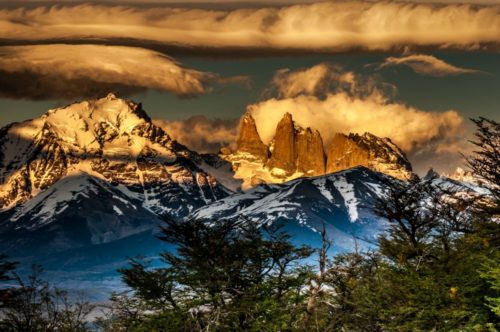
South America’s Patagonian Highlights
Glaciers in El Calafate, mountains in Torres del Paine, sophistication in Buenos Aires & Santiago
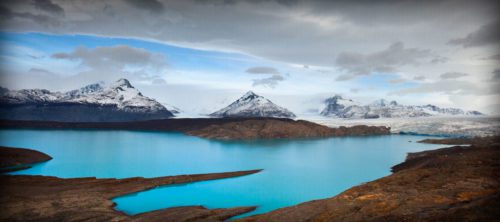
Adventurous Argentina & Chile
Glaciers, Lakes and Peaks Of Patagonia
Keep reading about Patagonia

- South America
Which Side of Patagonia to Travel to? Expert Tips to Guide Your Choice
Encompassing 260,000 square miles, Patagonia is a vast region of awe-inspiring mountains,…
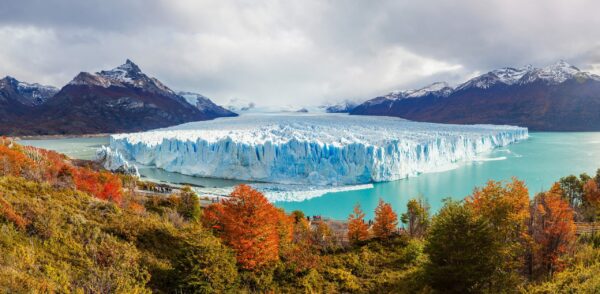
- Activities and Experiences
- Andean Mountains
- Travel Guides
The Best Hikes in South America
Are you ready for the hike of a lifetime? Check out our top picks for the best hiking in…
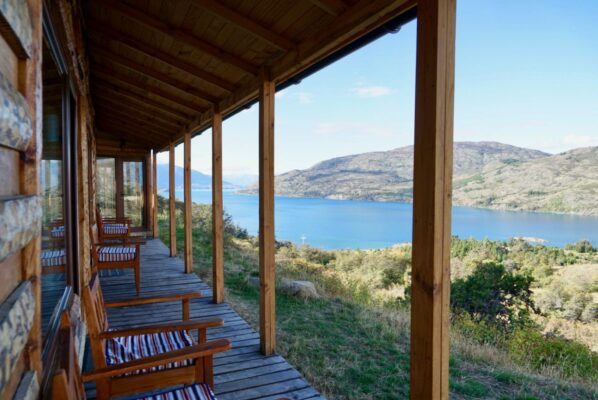
- Conservation
- Travel Tips
- Where To Stay
The Best Ecolodges in Chile’s Aysén Region
Whether it’s through investing in conservation initiatives, operating with a light…
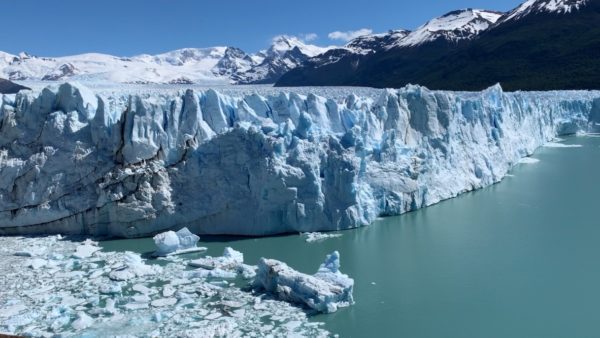
Southern Patagonia: What You Need to Know Before You Go
Discover 7+ reasons why Southern Patagonia’s stunning landscapes and active adventures…
Plan your Trip
Ready to start planning your own incredible adventure? We make the process stress-free and enjoyable.
Annular solar eclipse 2024: Everything you need to know about the next solar eclipse
After the Great North American Eclipse comes a long "ring of fire" annular solar eclipse that can be seen in some iconic destinations.

- What is it?
- Where to see it from
- Viewing locations and timings
- Why so special?
- Partial solar eclipse viewing locations
- Next annular eclipse
Additional resources
Now that the "Great North American Eclipse" is over, you may be itching for the next opportunity to witness another celestial marvel. So when is the next solar eclipse ?
The next total solar eclipse is more than two years out, on Aug. 12, 2026, in Greenland, Iceland and Spain. However, on Oct. 2, 2024 , a "ring of fire" annular solar eclipse will pass over parts of the Pacific Ocean, southern Chile and southern Argentina.
Whereas 43.8 million people were able to experience totality for the April 8, 2024, eclipse in North America, only 175,000 people will have that opportunity for the Oct. 2 annular solar eclipse, according to Time and Date . The paths of both eclipses cross in the Pacific Ocean .
During an annular solar eclipse, it is NEVER safe to look directly at the sun without solar eclipse glasses designed for solar viewing. Read our guide on how to observe the sun safely .
So, ready to go eclipse chasing? Here's everything you need to know about the annular solar eclipse on Oct. 2, 2024, in Chile and Argentina.
What is an annular solar eclipse?
The Oct. 2 eclipse will be very similar to the annular solar eclipse on Oct. 14, 2023 , which was visible across the U.S. Southwest, Central America and South America. All solar eclipses occur when a new moon is positioned precisely between Earth and the sun and casts its shadow on Earth. However, unlike a total solar eclipse, an annular solar eclipse occurs when the moon is slightly farther from Earth. So, even when the disks align from our perspective, the moon's shadow doesn't completely block out the sun's light. Instead, a ring of sunlight is visible around the moon.
Related: What's the difference between a total solar eclipse and an annular solar eclipse?
The eclipse on Oct. 2, 2024, will have an eclipse magnitude of 0.9326, according to EclipseWise.com . That means about 93% of the sun will be blocked by the moon during the eclipse, resulting in an "annulus" (Latin for "ring"). The moon will appear 6.4% smaller than average, according to MoonBlink .
The closer the observer is to the centerline, the more circular the ring of fire will be and the longer it will last. But experienced eclipse chasers often observe from the edge of the path during an annular solar eclipse to see extended views of Baily's beads fizzing around where the limb of the moon appears to touch the sun. They can be visible for several minutes.
From where can you see the Oct. 2 annular solar eclipse?
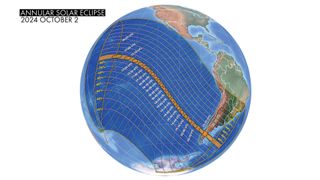
The ring of fire will be visible only within a path of annularity that passes across the Pacific Ocean, southern Chile and southern Argentina.
This area will include the volcanic island of Rapa Nui/Easter Island, an iconic travel destination that's famous for the mysterious stone statues called moai, some of which reach 40 feet (12 meters) tall and weigh 75 tons. The island, which is only 63 square miles (163 square kilometers), is located 2,300 miles (3,700 km) from the Chilean coast, making it the most isolated inhabited landmass on Earth. Remarkably, it will be the second time a central solar eclipse has been visible from this tiny Pacific island in recent decades, with a total solar eclipse glimpsed there on July 11, 2010 . The next total and annular eclipses there will be in 2324 and 2345, respectively.
A good option would be to position yourself slightly south of a moai at multiple sites to get a view of the ring of fire just above one of the statues, according to the Atlas of Solar Eclipses — 2020 to 2045 . Iconic locations will include the platform at Ahu Tongariki, where 15 moai are positioned on a 200-foot-long (60 m) ceremonial platform and nearby Rano Raraku.
October's ring of fire will also be visible from southern Patagonia in Chile and Argentina. The path will be 180 to 185 miles (290 to 300 km) wide.
Where and when can I see the Oct. 2 annular solar eclipse?
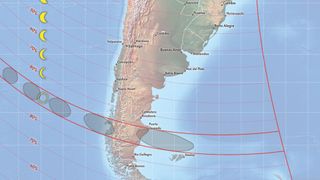
Here are some places eclipse chasers will gather for this annular solar eclipse:
- Rapa Nui/Easter Island, Chile (5 minutes, 38 seconds to 6 minutes, 12 seconds of annularity starting at 14:03 EAST, 67 degrees above North)
- Cochrane, Chile (5 minutes, 40 seconds of annularity starting at 17:21 CLST, 26 degrees above NNW)
- Perito Moreno National Park , Argentina (6 minutes, 17 seconds of annularity starting at 17:21 ART, 25 degrees above NNW)
- Puerto Deseado, Argentina (3 minutes, 22 seconds of annularity starting at 17:27 ART, 20 degrees above NNW)
- Puerto San Julian, Argentina (5 minutes, 12 seconds of annularity starting at 17:24 ART, 21 degrees above NNW)
Organized eclipse-viewing tours include Sky & Telescope , TravelQuest and AstroTrails . All are experienced eclipse tour operators that are headed to Rapa Nui/Easter Island.
What will the weather be like for the Oct. 2 annular eclipse?

It's always best to travel somewhere you want to visit regardless of a solar eclipse. That certainly applies to the Oct. 2 event, because the prospects of a completely clear sky are relatively low. The chances of clouds that day are 75% for Rapa Nui/Easter Island,, 90% for Perito Moreno National Park, and 65% to 70% for locations on Argentina's Atlantic coast, according to Time and Date .
On Rapa Nui/Easter Island, the cooling of the land could cause convective clouds to dissipate, according to Eclipsophile , with the south coast statistically slightly favored. The chances of seeing the ring of fire are smallest on Chile's Pacific Coast and highest on Argentina's Atlantic coast. The latter has the least interesting scenery of anywhere in the path, but the eclipse will arguably be a more dramatic sight because it will occur much lower in the sky.
Why is the Oct. 2, 2024, annular solar eclipse special?
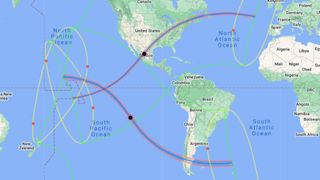
The Oct. 2, 2024, annular solar eclipse is special for three very different reasons. First, it follows the Great North American Eclipse of April 8 — so interest in solar eclipses should be high, and many eclipse chasers will travel to see it.
Second, it's a long eclipse, with the ring of fire lasting up to 7 minutes, 25 seconds. That's much longer than the 4 minutes, 52 seconds possible in the U.S. during the last annular solar eclipse on Oct. 14, 2023.
Third, the best place to view this event is a truly iconic destination: Rapa Nui, also called Easter Island.
Where to see the partial solar eclipse on Oct. 2
Although a ring-of-fire eclipse will be visible only from the aforementioned areas of Chile and Argentina, other areas will experience a partial solar eclipse on Oct. 2. These areas include parts of the Pacific Ocean and the southern half of South America. Here's what percentage of eclipse will be seen from major cities and destinations in the partial-eclipse zone:
- Galapagos Islands (1%)
- La Paz, Bolivia (1%)
- Rio de Janeiro, Brazil (9%)
- São Paulo, Brazil (10%)
- Buenos Aires, Argentina (42%)
- Montevideo, Uruguay (42%)
- Santiago, Chile (44%)
- Villarrica, Chile (63%)
- El Calafate, Argentina (83%)
- Falkland Islands (84%)
- South Georgia Island (76%)
- Punta Arenas, Chile (75%)
- Ushuaia, Argentina (72%)
- Elephant Island (56%)
- Port Lockroy, Antarctica (44%)
After October 2024, when is the next annular solar eclipse?
Here are the dates and locations for some upcoming annular solar eclipses:
- Feb. 17, 2026 : Antarctica
- Feb. 6, 2027 : Chile, Argentina, Uruguay, Côte d'Ivoire, Ghana, Togo, Benin and Nigeria
- Jan. 26, 2028 : Galapagos Islands, Ecuador, Brazil, French Guiana, Portugal, Morocco and Spain
- June 1, 2030 : Algeria, Tunisia, Greece, Turkey, Russia, Kazakhstan, China and Japan
Want to look further ahead? You can find a concise summary of solar eclipses out to 2030 on NASA's eclipse website . Read more about solar and lunar eclipses on EclipseWise.com , a website dedicated to predictions of eclipses. See beautiful maps on eclipse cartographer Michael Zeiler's GreatAmericanEclipse.com and interactive Google Maps on Xavier Jubier's eclipse website. You can find climate and weather predictions by meteorologist Jay Anderson on eclipsophile.com .
Bibliography
Anderson, J. (February 2024). Annular Solar Eclipse
2024 October 2. Retrieved March 1, 2024 from https://eclipsophile.com/annular-solar-eclipse-october-2-2024/
Bakich, M. and Zeiler, M. (2022). Atlas Of Solar Eclipses 2020-2045.
https://www.greatamericaneclipse.com/books/atlas-of-solar-eclipses-2020-to-2045
Espenak, F. Solar Eclipse Prime Page: Annular Solar Eclipse of 2024 October 2. Retrieved March 1, 2024 from: https://eclipsewise.com/solar/SEprime/2001-2100/SE2024Oct02Aprime.html
Jubier, X. (n.d.). Solar eclipses: Interactive Google Maps. Retrieved March 1, 2024 from http://xjubier.free.fr/en/site_pages/SolarEclipsesGoogleMaps.html
Time and Date. (n.d.). October 2 2024 Annular Solar Eclipse. Retrieved March 1, 2024 from https://www.timeanddate.com/eclipse/solar/2024-october-2
Join our Space Forums to keep talking space on the latest missions, night sky and more! And if you have a news tip, correction or comment, let us know at: [email protected].
Get the Space.com Newsletter
Breaking space news, the latest updates on rocket launches, skywatching events and more!

Jamie is an experienced science, technology and travel journalist and stargazer who writes about exploring the night sky, solar and lunar eclipses, moon-gazing, astro-travel, astronomy and space exploration. He is the editor of WhenIsTheNextEclipse.com and author of A Stargazing Program For Beginners , and is a senior contributor at Forbes. His special skill is turning tech-babble into plain English.
Why I watched the solar eclipse with my kids, a goose and 2,000 trees
'You could feel the energy and wonder': Despite clouds, totality wows crowds during solar eclipse in Syracuse
The 2024 solar eclipse was a teachable moment in more ways than one
Most Popular
- 2 Iconic British meteorite 'Winchcombe' found to have a smashing past
- 3 Object that slammed into Florida home was indeed space junk from ISS, NASA confirms
- 4 Venus is leaking carbon and oxygen, a fleeting visit by BepiColombo reveals
- 5 I flew Boeing's Starliner spacecraft in 4 different simulators. Here's what I learned (video, photos)
New fossils reveal one of the smallest titanosaurs ever found
Ten times smaller than other titanosaurs, Titanomachya gimenezi reveals new details about life in ancient Patagonia before the asteroid wiped out the dinosaurs.

A new dinosaur discovered in Patagonia is among the smallest of giants. Named Titanomachya gimenezi , the long-necked herbivore belonged to a family of usually immense dinosaurs called titanosaurs. But even fully grown, Titanomachya was about the size of a cow—albeit, a very hefty cow.
The new dinosaur was uncovered by Museo Paleontológico Egidio Feruglio paleontologist and National Geographic Explorer Diego Pol and his colleagues as part of their scientific quest to understand how the end of the age of dinosaurs played out in South America. To date, the majority of what paleontologists know about the last days of the dinosaurs—a period known as the late Cretaceous—stems from fossil finds from the Northern Hemisphere, and in particular, North America.
But as Pol and other paleontologists working in South America are demonstrating, the continent has several crucial fossil hot spots that are yielding untold new species and a more detailed view of life in the few million years before the catastrophic asteroid impact that ended the Cretaceous with a bang some 66 million years ago . (Learn more about how scientists are reimagining dinosaurs.)
This new titanosaur is the latest find from the region. So far, Pol and his colleagues have uncovered more than 20 fossil-rich sites dating to the late Cretaceous in Argentina. And one of them—the La Colonia Formation of central Patagonia—is where the researchers found a smattering of bones from a long-necked sauropod. No sauropods had ever been found before in this formation.
“Prior to this discovery, there were no records of sauropod dinosaurs in this region,” Pol says. The find was described April 11 in the journal Historical Biology .
Solving the puzzle
Piecing the dinosaur together was like solving a giant jigsaw puzzle, the researchers say.
FREE BONUS ISSUE
“The remains were disarticulated but placed very close to each other,” Pol says.
Back at the lab, the team found they had uncovered ribs, vertebrae, limb bones, and part of a hip. They named the reptile Titanomachya gimenezi after the moment the Olympians battled the titans in Greek mythology, known as the Titanomachy, and the work of paleontologist Olga Giménez.
Despite having just one partial skeleton, the bones are distinct enough from other dinosaurs to justify the new-species distinction, says Universidad Maimónides paleontologist Pablo Gallina , a National Geographic Explorer who was not involved in the new study. Particularly striking is just how small this new dinosaur is.
“When one thinks of these titanosaur sauropods, a large dinosaur with a long neck and tail comes to mind,” Gallina says. “Especially from Patagonia where the largest titanosaurs are found and reach 70 tons.” This dinosaur is just a fraction of the size.
From the dimensions of the fossilized limb bones, Pol and his co-authors estimate that Titanomachya weighed between five and 10 tons, but with the body dimensions of a large cow and a long neck and tail, reaching about 20 feet in length—so about the same length as a minibus.
You May Also Like

Rare fossils reveal a stunning scene from the final days of the dinosaurs

What made 'terror birds' so terrifying? New fossil prints reveal killer claws.

Dinosaur vs. mammal: 'Jaw-dropping' fossil reveals prehistoric battle
That is absolutely puny compared with other titanosaurs. The biggest titanosaurs were more than a hundred feet in length and weighed more than 70 tons. Titanomachya was a relative pipsqueak roaming what’s now Argentina near the very end of the Cretaceous around 67 million years ago.
The world of Titanomachya looked very different from the Patagonia the paleontologists know today. Back in the Late Cretaceous, Pol says, the area was dotted with coastal lagoons and estuaries. It was a wet and marshy place, stalked by the “meat-eating bull” Carnotaurus , and an ensemble cast of other diverse dinosaur species that paleontologists are only just now beginning to understand. Other expeditions to the La Colonia Formation where this titanosaur was found have, so far, turned up duck-billed hadrosaurs, armored ankylosaurs, and more. Titanomachya is perhaps just the tip of a fossil iceberg.
Why Titanomachya was so small, however, is a mystery. “The body size is particularly striking, not only for this species but also for other titanosaurs that lived in Patagonia towards the end of the Cretaceous,” Pol says.
Experts are investigating several hypotheses for its minuscule size—including that its smallness was a result of titanosaurs adapting environmental pressures.
“One possibility is the reduction of available land area due to the transgression of the Atlantic Ocean that covered large extents of Patagonia,” Pol says. About half of Patagonia’s land area was once blanketed by shallow sea. Paleontologists have evidence from other fossil sites, such as the remnants of Cretaceous islands in what’s now Transylvania, that show sauropod dinosaur species sometimes evolve to be smaller to help them survive in tight spaces with less food.
Other environmental changes might have played a role as well. “Significant changes in ecosystems and climate could have affected the size of titanosaurs,” Pol says. Researchers studying the region’s fossils will continue to investigate this question, though.
More fossils will help reveal broader environmental trends. To paint that picture, they will need to involve far more diverse species than dinosaurs. “We believe we are just beginning to uncover the world of the end of the Cretaceous in Patagonia,” Pol says.
“Our project focuses not only on dinosaurs but also on plants, invertebrates, and other animal groups.” Ultimately, he wants to help create a detailed picture of Cretaceous ecosystems before they were wiped away by disaster.
Such a holistic view of life in the years before the asteroid impact that ended the age of the dinosaurs is, in turn, essential to understanding how the world changed as a result of that mass extinction event .
“The end-Cretaceous extinction was a global biodiversity crisis,” Pol says, which requires evidence from around the world to understand.
In Cretaceous-era Patagonia, for example, paleontologists are finding evidence that the land, flora and fauna were undergoing significant changes. Titanosaurs like Titanomachya were beginning to disappear, while other herbivores, such as hadrosaurs and ankylosaurs, were taking up new roles in the ecosystem. Ultimately, this tiny titan marks a shift that would end with one of the greatest calamities of all time.
Related Topics
- SPECIES DISCOVERY
- PALEONTOLOGY

Early spinosaur bones reveal the rise of an unusual dinosaur dynasty

New evidence of decapitations points to this Triassic predator’s fatal flaw

Could dinosaurs swim? A new fossil revives an age-old debate.

Dino nuggets ... for dinosaurs? A young tyrannosaur’s last meal gives new insight

A dinosaur ‘belly button’? This 130 million-year-old fossil reveals that—and more
- Perpetual Planet
- Environment
- Paid Content
History & Culture
- History & Culture
- History Magazine
- Mind, Body, Wonder
- Gory Details
- 2023 in Review
- Terms of Use
- Privacy Policy
- Your US State Privacy Rights
- Children's Online Privacy Policy
- Interest-Based Ads
- About Nielsen Measurement
- Do Not Sell or Share My Personal Information
- Nat Geo Home
- Attend a Live Event
- Book a Trip
- Inspire Your Kids
- Shop Nat Geo
- Visit the D.C. Museum
- Learn About Our Impact
- Support Our Mission
- Advertise With Us
- Customer Service
- Renew Subscription
- Manage Your Subscription
- Work at Nat Geo
- Sign Up for Our Newsletters
- Contribute to Protect the Planet
Copyright © 1996-2015 National Geographic Society Copyright © 2015-2024 National Geographic Partners, LLC. All rights reserved

IMAGES
VIDEO
COMMENTS
The best time to go to Patagonia for trekking, horseback riding, white-water rafting, ice climbing, kayaking, wildlife spotting and more. ... 12 unmissable hikes in Patagonia: wonder at the pristine wilderness 10 things to do in Patagonia Why to visit Argentina's Patagonia National Park. Explore related stories. Read more articles. Tips & Advice.
Some of the best Patagonia weather is in November, with summer just around the corner. The warmest and driest time is January and February. As a result, these months are also the peak season when all tour operators are open, and hotels are usually packed. Keep Reading: The 31 Best Places to Visit in South America.
This is (understandably) the most popular time to visit Argentine Patagonia. The weather is warm (reaching into the 70s) and the region's attractions are ready for exploration.
Fall in Patagonia. March to May. Patagonia's autumn is another popular season for visiting as the landscape comes alive with fall colors. From March to May, average temperatures range from 41°F to 59°F (5°C to 15°C), creating a perfect time for hiking and immersing yourself in the region.
Spring in Patagonia is from September until early November, and Patagonia is quieter, but begins picking up into November. December and January are the busiest time to visit, with plenty of tourists and locals visiting the parks during their holidays. Continue on for a month-by-month breakdown of the best time to visit Patagonia!
Covering more than 400,000 square miles across both Chile and Argentina, Patagonia is an outdoor paradise unlike any other on the planet, making it a must-see destination for any adventure traveler. ... The best time to visit Patagonia depends on your travel desires. If weather is your primary concern, the most predictable conditions occur ...
Spring sees wild flowers and snow melt, the reopening of the best hiking routes and increased wildlife activity.; Summer brings up to 18 hours of daylight, with busy walking trails and high demand for accommodation.; Autumn colours light up Patagonia, making for beautiful scenery but with sparser crowds to make this a perfect time to visit.; Winter snows shut down most of the region, but some ...
Patagonia's weather is characterised by unpredictability; warm, windproof and waterproof layers are essential year-round - especially given the relentless wind. November to March is the best time to visit Patagonia, with warmth and longer days on both the Chile and Argentina sides. Southern nights last a scant six hours, although night ...
Best Times to Visit Argentina for Good Weather . The weather tends to be relatively moderate in many parts of Argentina throughout the year, but major cities like Buenos Aires can get very hot ...
The best time to travel to Patagonia is from October until the end of March. During those months it will be spring, summer and just the start of autumn in Patagonia. Patagonia is known for its strong winds and chiller summers than the Northern parts of Argentina and Chile.
Many consider the summer season as the best time to visit Patagonia. However, we recommend the shoulder seasons (October - November, and March - April) when travelers can enjoy walking the trails with fewer crowds. From October to November, Patagonia blossoms into spring with wildflowers of every color. From March to April, autumnal hues of ...
For Hiking, Whitewater Rafting and Penguin-Sighting. If you want to do hiking, whitewater rafting, and penguin-sighting, you should visit Patagonia from December to February. During these months, the weather in Patagonia is warm, with 17 or more hours of daylight. The long daylight duration means you can witness the beauty of Patagonian lands more.
The best time to visit Patagonia is in the spring, summer, and fall, stretching from November through March. These months promise mild temperatures and long days of daylight. ... Argentina: Hikes and Estancias of Patagonia. Argentina Level 3+ 11 Days From $7,995. VIEW TRIP. Small Group Adventure. Patagonia: Tracking Pumas and Cruising the Fjords.
The Best Way to Experience Patagonia, According to a Travel Expert Jordan Harvey's 12-day Itinerary Around Argentina and Chile Jordan Harvey's 13-Day Itinerary Around Patagonia and the Atacama Desert
The best time of year to visit Patagonia vary depending on what you want to see and do. Here are the optimal things to check out based on the season you choose to visit in. ... Argentina's Los Glaciares National Park boasts the largest ice cap outside of Greenland and Antarctica. To get a break from the cold, stop by the El Calafate ...
Best Time to Visit Patagonia The windswept steppes of Patagonia feature some of the most stunning vistas in all of Argentina and Chile, but during the summer (from late November to early March) is the ideal time to visit this enchanting region. Since it is in a remote corner of the world, even the high season does not imply heavy tourist traffic.
Weather-wise, January is a fantastic time to visit Patagonia. To get away from the crowds, explore the rugged landscape of the Chiloé Archipelago near Puerto Montt. (We love to base clients at Tierra Chiloe .) With average temperatures of around 63°F, it's still warm enough to layer up and kayak, go horseback riding, and visit the island ...
Seasonal Planning for Patagonia Travel. Argentina and Chile are in the southern hemisphere, meaning that December through February are summer months (and peak travel time) while July is in the dead of winter. As a general rule, summer has the best weather, while fall and spring have the best prices and fewer crowds.
Patagonia is a vast territory in the far southern end of South America with imposing landscapes, pristine wilderness, and very unpredictable weather. While every season has its magic, if you are looking for the best time to visit, it's definitely between November and March. This period, comprising the end of spring and the full summer season ...
October's ring of fire will also be visible from southern Patagonia in Chile and Argentina. The path will be 180 to 185 miles (290 to 300 km) wide. ... It's always best to travel somewhere you ...
A new dinosaur discovered in Patagonia is among the smallest of giants. Named Titanomachya gimenezi, the long-necked herbivore belonged to a family of usually immense dinosaurs called titanosaurs ...